 Age is just a number. Trust me when I say this. I just turned 55(!)
Age is just a number. Trust me when I say this. I just turned 55(!) 



Photo by my very talented photographer friend Makoto Ishida.
 Age is just a number. Trust me when I say this. I just turned 55(!)
Age is just a number. Trust me when I say this. I just turned 55(!) 



Marie Claire Taiwan asked me about career change from corporate to art. What I want you to know before pursuing your dream career.
June issue of Marie Claire Taiwan June 2015 issue had a feature article where four women in different career paths were interviewed for our career changes, and to give advise to those who aims for the same. I am happy to be chosen as one of the four. Below is the original correspondence I had with Jasper Hsu, feature editor of MC. Since I get asked about this career change often, I thought it was a nice opportunity to share my thoughts. Hope this is useful to some of you.
If you wish to read the original Traditional Chinese edition, please click on the image to enlarge.

Could you briefly introduce your background, and what made you move from Japan to New York?
I moved from Japan to New York to attend School of Visual Arts to study illustration. Also, it was a conscious move to get work permit in the USA. In the US, by receiving a higher degree from an accredited universities, the government grant one year work permit to international students. I wanted to move to New York as much as I wanted to be an artist, so going to school here was the easiest (not so easy though) way to move to NY.
You graduated from one of the top universities in Japan, came from a PR background, then become an illustrator. That was quite a leap, how did that all happen? Did you always know you had passions for art?
I always loved drawing, ever since I was old enough to hold a crayon. It was always my hobby. One of those kids, when it is sunny and nice out, and almost all your classmates from elementary school are outside after lunch playing dodge ball, there are always like 3-4 kids who stay inside and draws in their notebooks. That was definitely me.
When I was 12, my father’s job moved our family to New York, and I lived here for four years during middle school. I went back when I was starting high school. But with completely different life experiences in the US, I had difficult time adjusting back to ’orderly’ life in Japan. I felt I was never accepted back in as ‘one of us’ from very homogenous Japanese society. That was an ongoing struggle since the day I went back to Japan until when I finally came back to New York.
My parents were not so crazy about the idea of me going to art school (they think of Van Gough when they think of working artists), and I was also not so sure about what exactly I wanted to do with life (I was like 17 after all). So I ended up going to a regular university. I got really good grades in high school, so I got accepted into a good university on recommendation, thus avoiding notorious Japanese college entrance exam system.
I studied advertising and marketing in college, because I thought it was the most creative of the practical field. I still wanted to do something creative after all. And it was kind of a no brainer set path to get a job in corporate PR with that background from college.
I knew working in corporate was not for me. I understood it from the day one. To prove this, I didn’t open the savings account for company pension, which most of my colleagues did right when then started on the position. From day one, I thought I would quit in a few years. Then years passed by…. There were a few different reasons. One, I didn’t know what the hell I wanted to do with my life. OK, quit my job, and then what? I didn’t have the answer. Two, the job itself was kind of interesting. Three, people who I worked with were kind of nice. Four, that steady paycheck that comes in automatically every month…
When I turned age 30, I started think, REALLY think. Think that I shouldn’t just waste my life like this. But I didn’t have a concrete plan. Around then, I got a really really mentally abusive bosses. Not A boss, but TWO bosses. They made my working life HELL.
Funny thing is, when you hit the rock bottom, you really see things clearly. Sometimes, rock bottom is important because of that. (Though, I hope to never hit it again, and I never with it upon anyone.) That was when I realized I should pursue more meaningful life. You only live once, and you can’t really waste time like this! So, that’s when I made up my mind to 1) study art 2) move to New York.
Instead of becoming a full-time artist, have you thought about keeping your old job and working as an artist on the side or making it just a hobby?
That’s kind of what I did when I was working for 11 years, and it was clearly not working out.
Sometimes in life, you need to bid on a big gamble.
Also, when I decided I really wanted to pursue art and illustration, my goal was to aim for a small fish in the big pond, the biggest pond (New York). Where you are surrounded by most inspiring people you would look up to, and with a possibility that one day you can may be grow to be a big fish in that pond just like them. Go big or go home. No in between.
I’m glad I did that.
Did you experience any struggles when you first started studying art? How long did it take for you to become a full-time freelance illustrator?
Nothing is easy. Every day is a struggle, even now. But the life is full of struggles, so why not struggle in the life you love to live?
I went back to undergraduate first year, so I was 34, and all my classmates were around 18. Though it was struggle, and I was poor living off of savings till I finished school, it was also one of the best times. I was, for the first time, living a life that I had chosen, and the chosen path was hard, but meaningful.
After I finished the second year in undergraduate, I switched to two year master’s program in Illustration from the same school (School of Visual Arts). Total of 4 years, and I graduated with MFA degree, and I pretty much started working full time freelance illustrator right out of school.
What’s the best and worst part of being a freelance illustrator? What does one have to prepare or have before plunging in?
That you are your own boss. You can work on your own pace and schedule. But of course, that means, you may be working ALL THE TIME. Also, if you get sick, your job is still there. Nobody can cover for you. You have to cover everything for yourself.
Freedom and responsibility come hand in hand.
Before you quit your old job and pursue new career, did you evaluate your financial status? Like how long you can support yourself with the money you had, etc.? What questions did you ask yourself?
Definitely. You need to take some gambles in life, but you also have to have enough chips on your table to play the game.
I initially wanted to leave a few years earlier than I actually did, but I realized I didn’t have enough money in my bank account to support myself through four years of school and living expenses in NY. So, I ended up sticking around with my old job for a few more years to save up enough.
US government won’t issue you a student visa unless you have a proof of bank balance to cover the number of years of study (tuition + living expenses), so there was no choice. It was hard extra years, but it worked out in a long run. I was very careful with spending, and when I graduated, I still had just enough money in my bank account to pay bills for extra six months or so. That helped me focus on getting my new career on track without getting another day job. In the end, that extra few years of wait was actually a wise move.
Did you have a time where you struggled the most trying to make ends meet or having no clients, not knowing where your next income was? Did you think about giving up?
The worries, about your career or life, would never go away. At the end of the day, you are always a freelancer, whether you are starting out, or you have 10+ years of experience. Your career and income depends on each job and each project that comes on your way. So, yes, some kind of worries always linger. But I don’t think I ever wanted to quit. I may be in a different position from other people who are interviewed. I moved across the ocean to a foreign country to pursue a different career. Not that I had a back up plan if I quit. I didn’t. So, where do I go if I quit?
You have to be very responsible and good about putting money aside, always have some extra money in the saving account for the rainy days, and especially in the beginning, keep your monthly bills as low as possible. Knowing the monthly bills are not expensive is a huge weight off your shoulders. I lived far out from the city center, I lived with multiple roommates. I was able to survive off of not much in the beginning. I don’t want to go back to those early days, but it definitely was a wise choice till my career was on the right track, and was able to afford a small apartment on my own in the city.
What advice can you give to those who want to leave their current jobs and pursue something more inspiring? In what situations would you advise against it?
Have a really clear goal where you want to be in five years, and based on that plan, work out each year accordingly in steps toward reaching there. It’s beautiful to take a big leap of faith in your life, that big gamble of your lifetime, but even that big gamble should be based on some kind of realistic view, especially financial reality. You may be happy to be really poor while pursuing your dream like I did, at the same time, you can’t run out of the money while you are working toward the goal.
Make a really good game plan, even if it means waiting for extra few years to pursue it. If you are really committed to make that life change, you will do it even after that extra time of wait. In a way, that’s how your commitment gets tested.
Good luck.
Yup. I got rejected from graduate school. It’s not a secret.
I want to talk about rejection, because it’s that time of the year.
Colleges are making decisions, and it’s the award season in my industry. That means, while there are people who are so excited to be receiving the acceptance letters they have been dreaming of, there are also those who cry over the disappointment of rejection letters.
I came back to art school at age 34. I had four year college degree in business, and worked in corporate PR for 11 years before I decided to go back to school to study illustration. I didn’t feel like doing total of 8 years of college, so I applied to graduate program when I was finishing up the first year. I ‘thought’ it was a natural thing to do, I ‘thought’ I was good, and I ‘thought’ I was ready. But I TOTALLY wasn’t.
After crying and bitching (yup I did) for a while, there miraculously came a point where I was surprisingly not sad anymore. I finally gave up on thinking about imagining myself as a grad student, and instead, started planning for the second year in college. I soon realized there were many many things I was still able to learn in undergraduate studies.
I ended up filling my schedule with anything and everything I ever wanted to learn.
That was the first year I took silkscreen class, which, till this day, is the skill set I use to color my work digitally (thank you Larry Wright). I studied fine art painting under Marilyn Minter (now one of the biggest stars of contemporary art as you may know. Luckily, it was a few years before her big break) who taught me how to bring fine art thinking into illustration. I took as many drawing classes as I could so I was able to finally connect what I picture in my head to the pictures I create with my hand. I sat in senior class (Thank you Tom Woodruff for allowing me) to participate in group crits, so at least I can learn from higher level of discussion (though my work level was not quite there yet).
And, most importantly, that was the year I made many friends with whom the friendship was going to last for many many years to come.
The following year, I applied to graduate school again. While I was waiting for the result, I had this clear idea in my head: “I’ve learned everything I ever wanted to learn in undergraduate. If I don’t get in this year, honestly, I have zero idea what I should do next school year.”
Then, I got the acceptance letter.
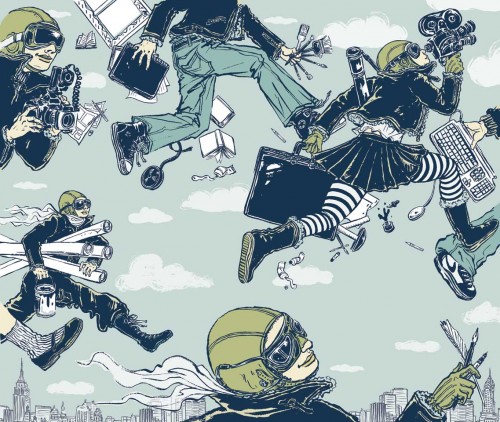
Looking back, I don’t think I would be working right now as a professional illustrator if I didn’t have that one extra year.
The year I didn’t get in, I was just not ready or meant to be a graduate student.
It was OK to feel sad, it was OK to cry. The important thing was the decision I made AFTER I was in peace with the rejection. I cannot be happier with what I did during that one extra year. Life threw lemons at me, and I made a delicious lemonade. Lemonade so delicious, if I ever get a chance to go back and re-live, I would even pay to buy that lemonade.
The truth is, life of being an illustrator is dealing with constant rejections. It won’t make it easier even if your name gets bigger.
Sorry you were not right for this project. We decided to change the directions. My editor didn’t love the sketches. We decided to run photo on the cover, etc, etc…
I appreciate when clients apologetically call to explain why the job got killed. I laugh off and tell them it’s totally OK, it is part of my job.
It is true I would have loved to get that big advertising campaign, or wished that TIME Magazine cover had run. But it was also totally OK they didn’t. There are many more projects to come in future, and more, and hopefully better, artwork I can create in future. Rejections in past helped to make my skin thicker to survive longer in the industry (plus more lemonade).
So, if you got accepted into schools, competitions, or anything else, congratulations to you. But if you didn’t get that acceptance letter, let’s start making lemonade. Surprise yourself with the best lemonade recipe you can ever come up with.
Trust me, you will one day look back and you would be SO glad you got that rejection.
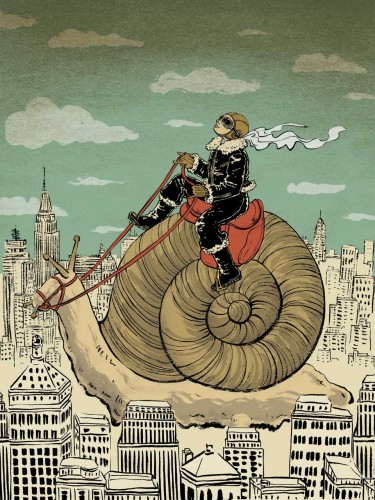 “Can you tell who’s going to make it in your class?” I sometimes get this big question. And my answer is YES, I CAN. Their eyes open up twice as big. But wait! I need to explain a bit more.
“Can you tell who’s going to make it in your class?” I sometimes get this big question. And my answer is YES, I CAN. Their eyes open up twice as big. But wait! I need to explain a bit more.
Recently in my class, a students, who is very talented, but lacking a bit of focus, and hasn’t been creating work up to his talent, said “I always wanted to be a concept artist, but not anymore”. I asked why. Initially he didn’t give me a good enough answer, but after talking for a few minutes, he finally said this:
“I find there are always people who are better than me, and I don’t think I can be as good.”
Now, this is not the best answer, but at least a good enough answer in a way that solving a problem starts from admitting the problem. Right?
So, going back to WHO MAKES IT.
The answer is this: those who dream big, and those who work hard toward it. Those are the ones, I can guarantee, who make it at the end. It’s that simple. It is never about how talented you are.
I have been teaching for 12 years now. I have met many students and aspiring illustrators. And let me reassure you, talent is NEVER the key to how one makes it or not. Of course, if you have the talent AND extremely hardworking, then, congratulations. You are unbeatable. (Stop reading this and just go back to the work you were doing, will you?) But the truth is, most us are not those very rare few. And that is totally OK.
I have seen many extremely talented students who ended up never making it. Because they relied too much on the gift they were born with, and never learned to work hard, because they felt they were just too cool for school, stopped listening to professors’ advices, etc, etc…, while others who are not as gifted worked their ass off and get better slowly but surely.
I think one of the best things that happened to me when I was still a student was the fact that my roommate was one of those very rare few. You know, that one person who was extremely talented AND hardworking, that you know you would never be.
The reality was, after that initial intimidation slowly faded away, I was able to just accept the fact there are ALWAYS going to be people who are better than you, and that is totally OK. It is an unnecessary distraction you should never focus on. By having that genius roommate, I was actually able to, from early on, not worry about looking at others and getting intimidated, and rather spend that energy focus on my work and my own strength.
I had a classmate who’s dream was to be a kids’ book artist. She started art later than most of her classmates. Thus her work at that point definitely looked that way. I asked an another classmate, “Do you think she will one day get a kids’ book deal?” The classmate answered without even hesitating for a second, “Oh yeah, for sure! She is so damn determined; I have no doubt she will! ”
One thing she did was she worked really REALLY hard. She listened and applied every advice and criticism instructors and classmates gave her. Sometimes things worked, sometimes things didn’t, but she never gave up. Her work got better slowly but surely each and every single day.
And guess what? More than a decade after graduation, while many of her classmates ended up going onto different paths, she is THE ONE with multiple kids book published, with more on her way, and teaching the next generation of aspiring kids book artists.
She had never stopped, for more than a decade, to have focus, work ethic, and a big dreams always close to her heart.

This is a portrait of a young man I created back in 2006 for a Christian magazine. This young man, who loved mountains and nature, unfortunately lost his life too early to drugs.
When I initially created this image, the father of this man contacted me because he liked the image, and I sent him an enlarged color print to put up on his home wall.
While my assistant and I were organizing flat file a few months ago, among a big pile of old work, I found the original b/w drawing. I thought of the father, but I couldn’t find his contact. Then last week, he e-mailed me out of the blue, because he wanted to show me a photo of the print up a wall in his new house. He said he made sure to hang the print so it is the first thing people see when entering the house. Thus I got his home address to FedEx him the drawing where it should belong.
This morning I got the most touching thank you message in my inbox. It really made my day.
I believe in power of art, and importance of it. At the same time, I always think of art as, “yeah, but it doesn’t save anyone’s lives” .
It doesn’t, but art does certainly make our lives richer. At least, it’s good to know that it does.
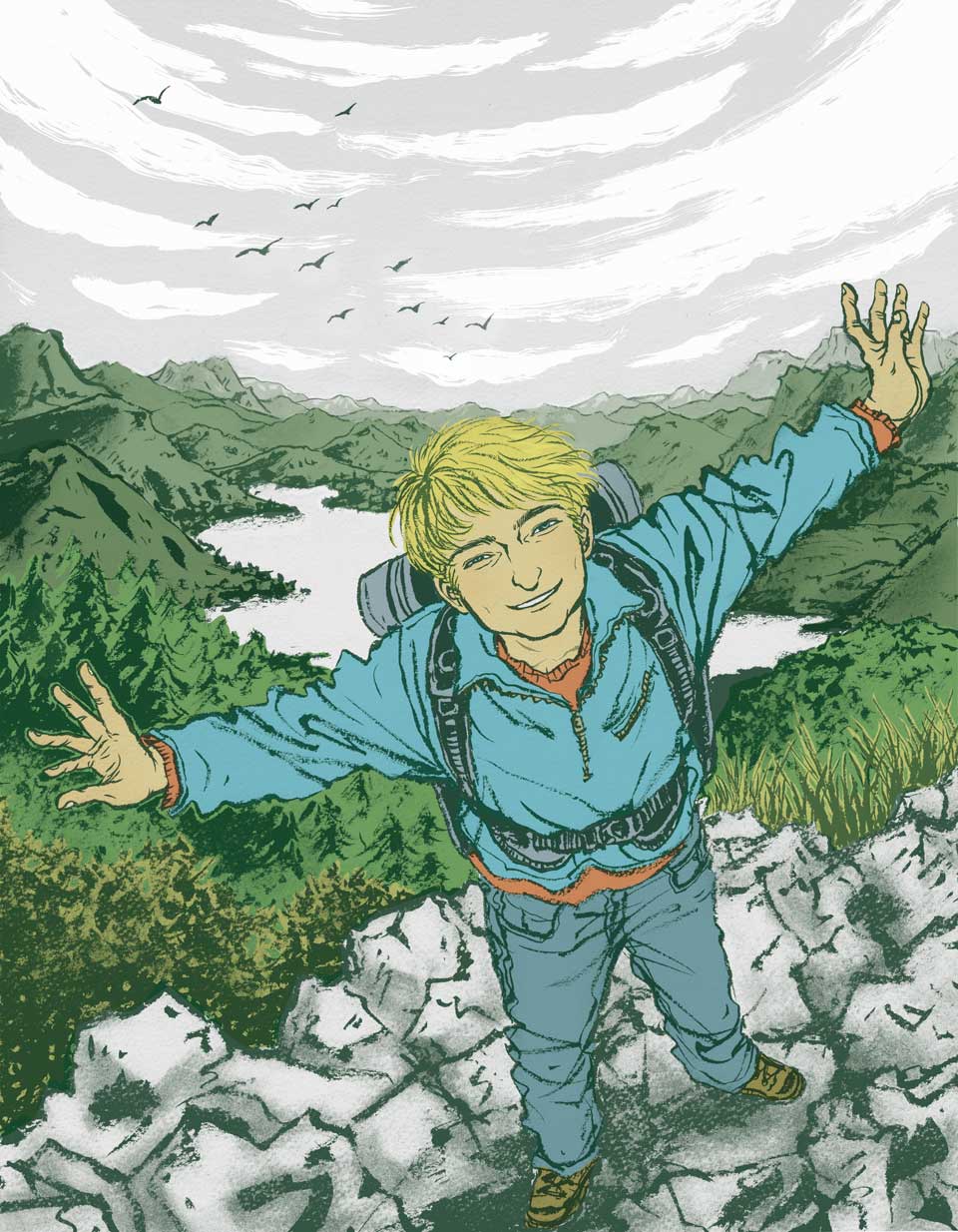
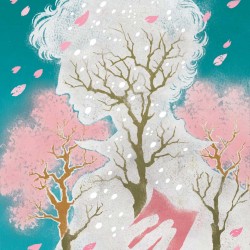 I was buying a box of cereal. I said “hi” to the girl at the checkout counter, but she didn’t even look up. She scanned the cereal box and throw it back at me without even saying how much the total was.
I was buying a box of cereal. I said “hi” to the girl at the checkout counter, but she didn’t even look up. She scanned the cereal box and throw it back at me without even saying how much the total was.
I try to be nice at the checkout counters. I look them straight in their eyes and say “hi, how are you?”, even when they look like they are not having a good day. Which is, well, most of the time. Their attitude changes, they smile back, and we part by saying ‘Thank you. Have a good day’ to each other.
The girl who threw the cereal box, though, she was taking her unhappiness out on me. I didn’t even feel like wasting my time patiently smiling at her. So I took the change, mumbled thank you inside my mouth and left.
The good thing is that I can forget this bad experience right when I step out of the store. On the other hand she has to stay working unhappily all day long.
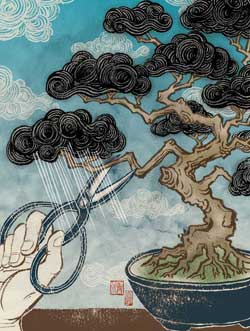
One of the most common questions young artists, especially those who just graduated, ask me is: “did you have to take a day job when you were starting out?”.
I don’t know exactly what they expect me to answer, and what is the intention of the question. However what I know is that this is not a simple yes or no answer for me. If you are asking about the time after finishing my MFA in illustration, my answer is no. But I also spent 11 years in corporate PR office job after I finished college before going back to art school much later in my life. So, the answer is yes if I count those 11 years as my day job. And I do.
The fact is that it was during my day job I learned everything about how to work efficiently, how to organize, multi-task, how to make good phone calls or to negotiate terms either with clients or with bosses and coworkers…. you name it. (including, minor things like don’t make phone calls before 10AM, don’t e-mail important topics on weekends or Mondays, which I still follow till this day.) In short, it taught me everything about how to run my small business of illustration later on.
When I went back to school as an art student at age over 30, I initially felt old and inferior to those bright 17 year olds in my classes. But soon realized that though I may have been old(er), I also had a lot of life experiences under my belt. Now, after finishing up exact same amount of time, exactly 11 years, of working as an illustrator, I often stop and think: would it have been even possible to be working as an illustrator for this long if I didn’t have that day job first? The answer to this is very clear to me.
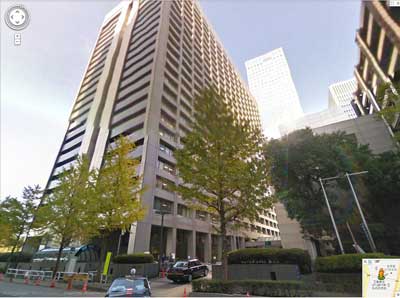 I was a hopeless 21 year old, who had no life experiences or social skill but thought I was someone special, like any other (or should I say most of) 21 year old may think. I used to pick fights with bosses when I thought I was right. (though I still think I was right in those cases! LOL.) I now know exactly how to talk that boss into letting me do what I think is a good idea, among everything else. (After all, any business is about person to person relationships. ) Yes, I learned them all during my day job.
I was a hopeless 21 year old, who had no life experiences or social skill but thought I was someone special, like any other (or should I say most of) 21 year old may think. I used to pick fights with bosses when I thought I was right. (though I still think I was right in those cases! LOL.) I now know exactly how to talk that boss into letting me do what I think is a good idea, among everything else. (After all, any business is about person to person relationships. ) Yes, I learned them all during my day job.
Though I never loved that job, which ultimately made me decide to leave and pursue my childhood dream of being an artist, I don’t regret the priceless experiences that later allowed me to jump start my ‘second career’. If I have a time machine to go back, I won’t change a thing.
I believe day jobs are too underrated. Maybe you feel inferior to those who don’t need to take that day job? Please don’t ever be ashamed! Trust me, there is a lot you can learn from any day job as long as you try to make best of it, even when the situation is not ideal. The reality is, business of art is half art and half business. There are far fewer young artists who are completely ready to run their own one person business when they graduate than those who are not. Think of it as you are given a special opportunity to get yourself ready.
When that day comes when you can finally let go of that day job, I guarantee you will be thankful for the experiences you have had. Besides, you will be So thankful for not have to work on day job anymore that you will focus and work even harder than if you didn’t have to go through it.
Trust my word. It’s all going to be good! (and let’s start from smiling while you are on the job.)
(PS: The last photo is a Google street view of the office building I worked for 11 years in Tokyo. Because I am just about to start the 12th year working on my second job, I thought it was a good time to talk about this now. Hope it would be helpful for some of you. Thank you. )
I use Google Maps all the time. You do too, right? I just used it yesterday to find out where exactly was the West Village restaurant I was going. And, oh, the closest subway stop. But it never occurred to me that I can use this to illustrate.
This illustration is for the current Mother Jones magazine (July and August 2013). Story is about how we are pretending the next super storm won’t arrive and believe our cities are going to be fine.
They asked for an image of New York City in flood where people carrying on their everyday lives like they don’t care.
The key was to pick a location that looks undeniably New York City, with enough open space to fill with crowd. Times Square was being suggested for obvious reasons. But then again, if you are a New Yorker, you know Times Square is for the tourists. You don’t go there unless you need to.
I ended up choosing 23rd Street where Broadway and 5th Avenue meet, right next to Madison Square Park. This is where you have a great view of Empire State Building, with two avenues going diagonally up north with lots of interesting looking buildings, a park to your right, and a big open space to draw bunch of people and some cars in.
This is also where I have been getting off the subway to go to School of Visual Arts (SVA) for last 14 years, first as a student, then as an instructor after I finished my MFA. It was a natural choice. (And may I mention my favorite restaurant in town, La Mar, is situated right near by?)
I initially downloaded bunch of photos online. Then realized, you can’t really get all the details from the online photo references.
I don’t know how I ended up going to Google Map street view. But I did.
Why didn’t I do this before? You can virtually walk up and down the avenues, to see the details of some buildings you cannot see in the reference photos. You can look up, then look right and left. This is PERFECT.
It saved me from going out in the miserable weather to sit on a street corner for hours and hours and possibly harassed by passers by, even laughed at for my wobbly drawing skill.
More New York city scape assignments? Bring them on.
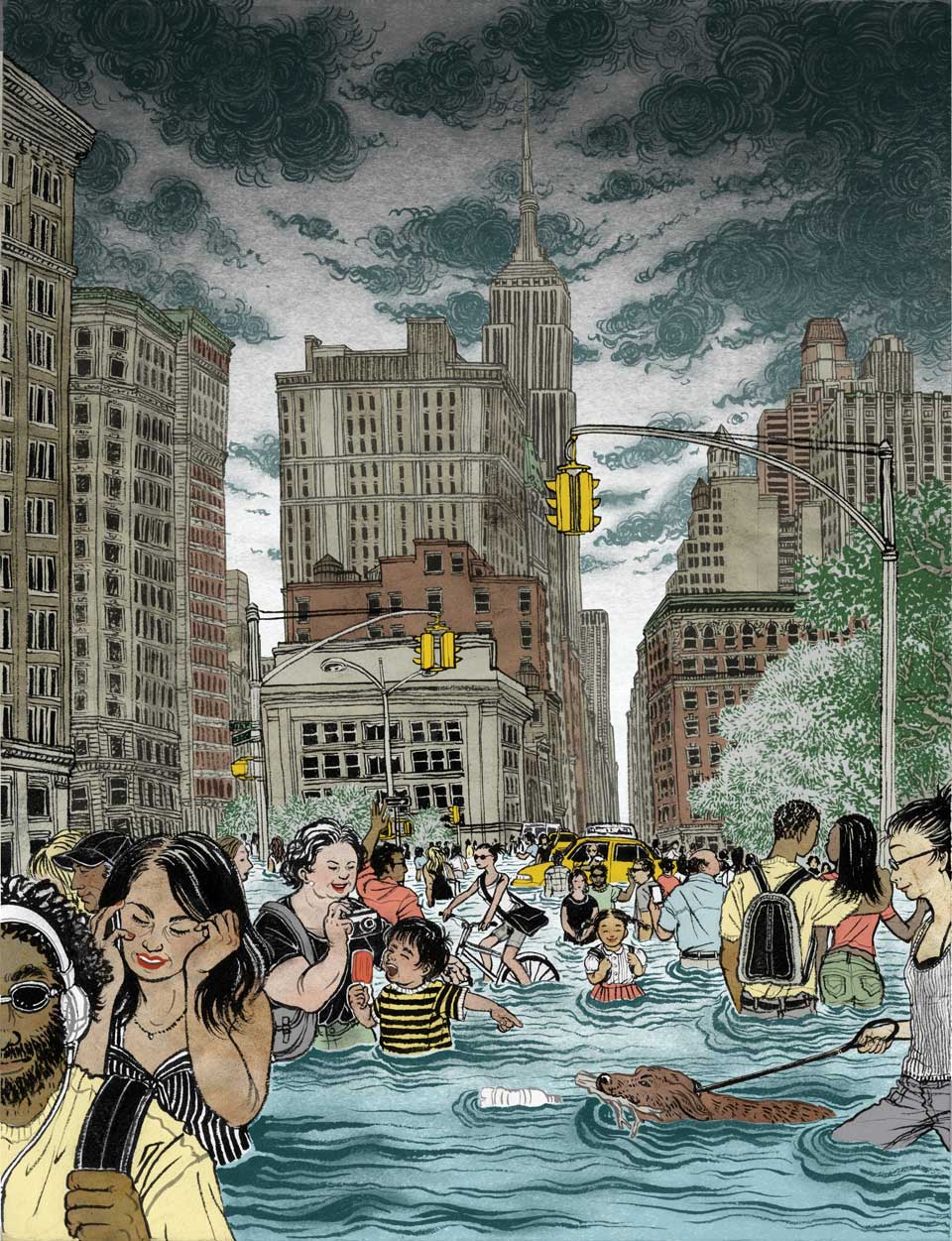
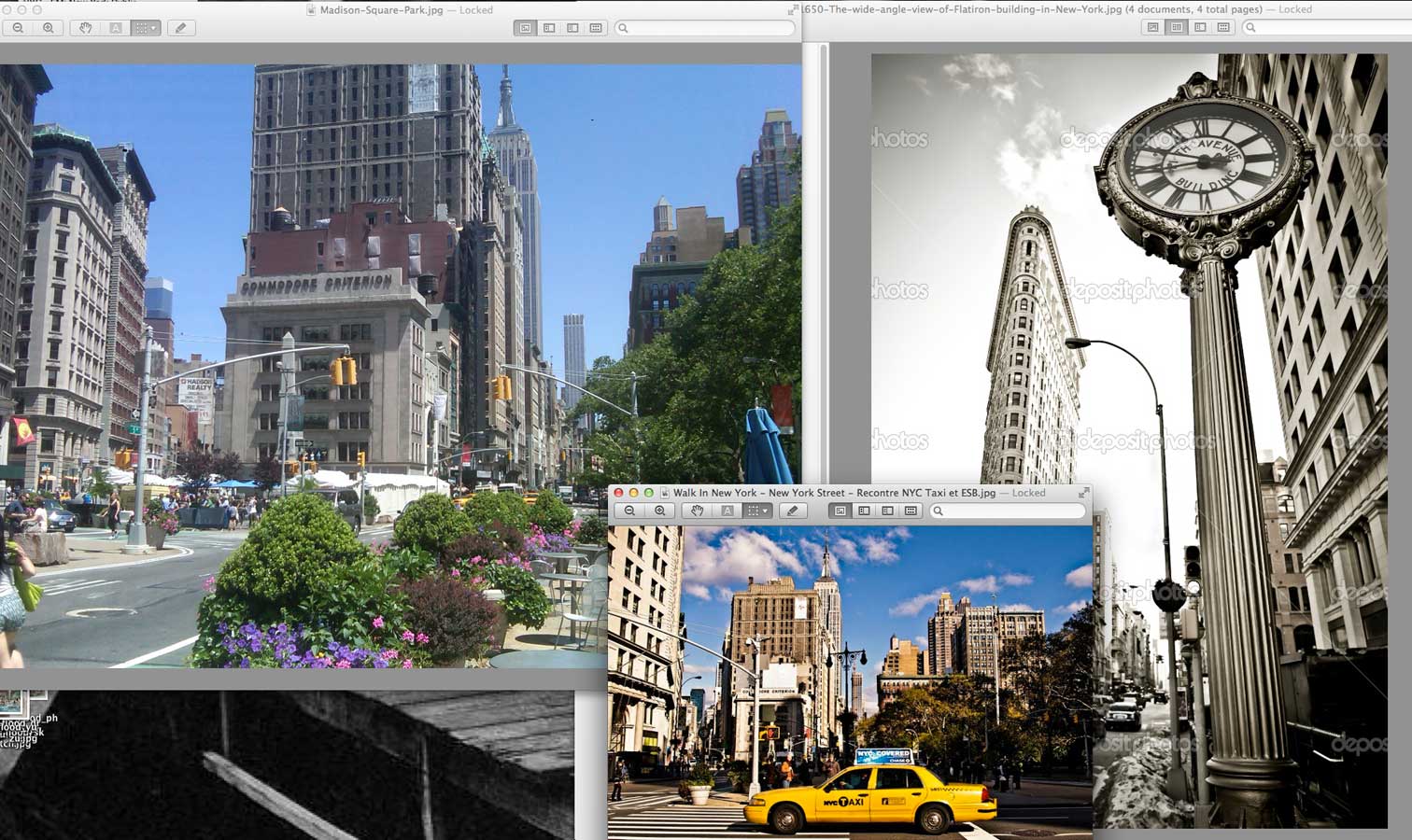
Initially I downloaded these photos of the location from various websites. I had noticed that though they are good photos, I cannot see enough of cityscape details to draw from.
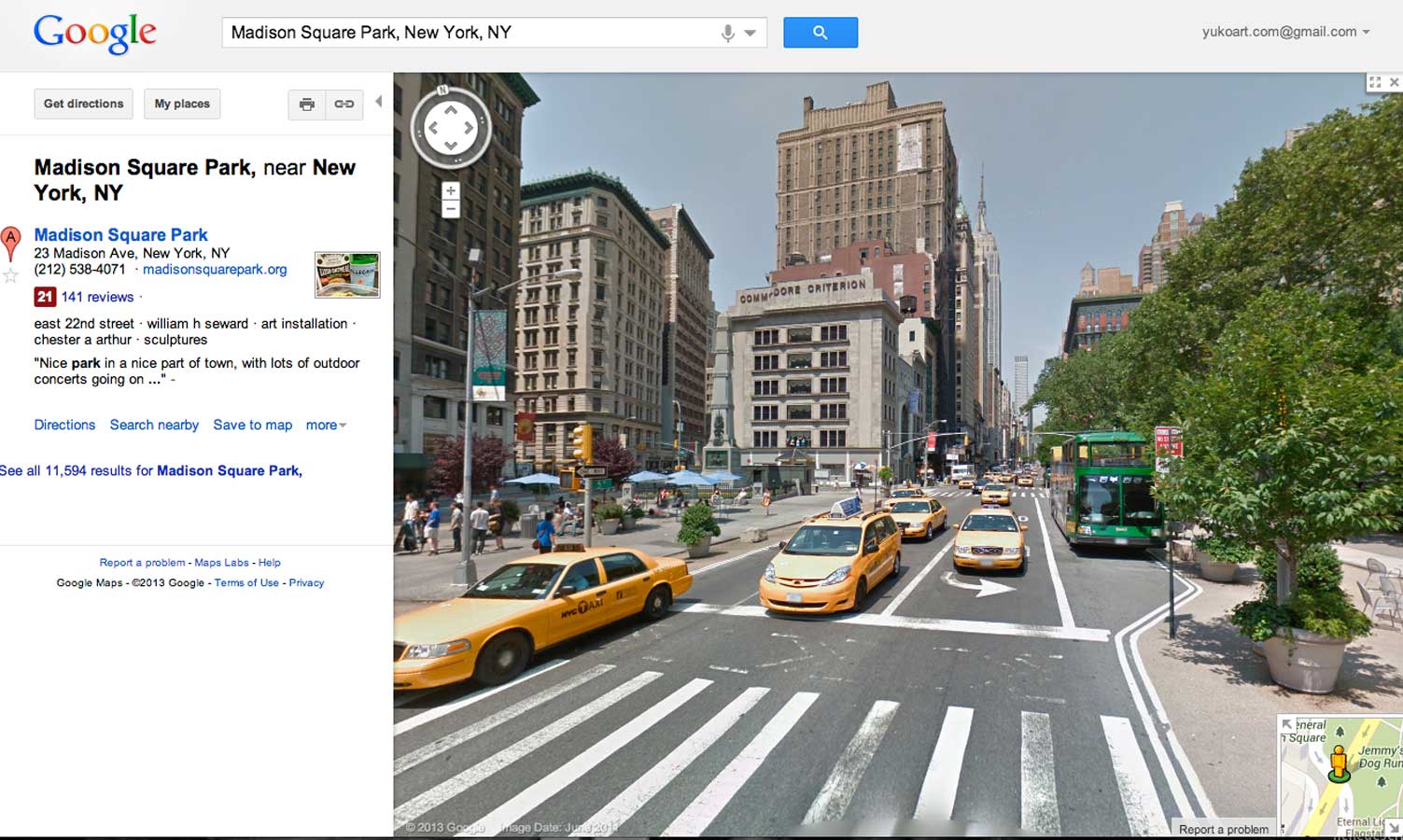 Then, here is Google Map Street View. I can walk up and down the avenues virtually.
Then, here is Google Map Street View. I can walk up and down the avenues virtually.
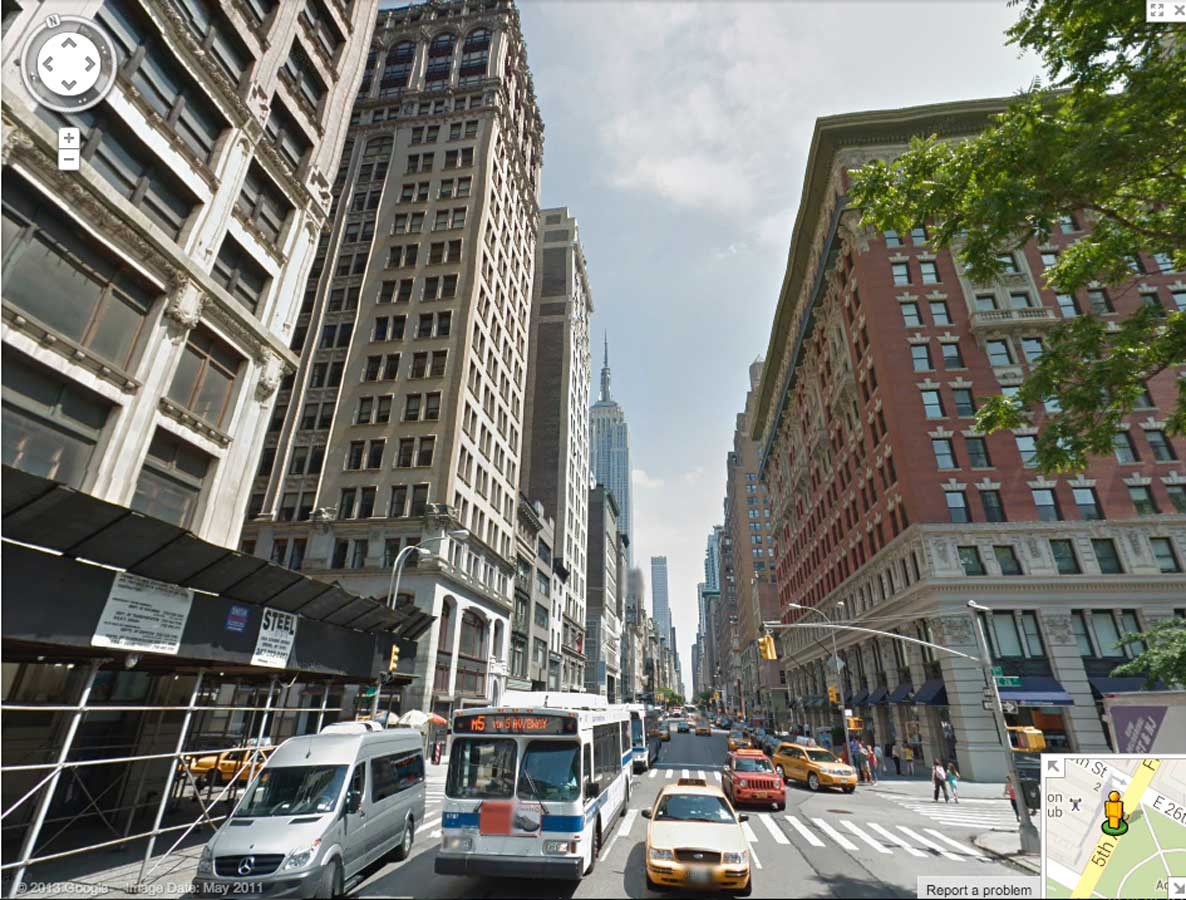 I really liked this pink building on the right, so I walked around it virtually to get the details and understand the structure.
I really liked this pink building on the right, so I walked around it virtually to get the details and understand the structure.

This is a rare cross streets where two avenues and a street meet all at once. So, I walk up and down the other avenue to understand the buildings surrounding it.
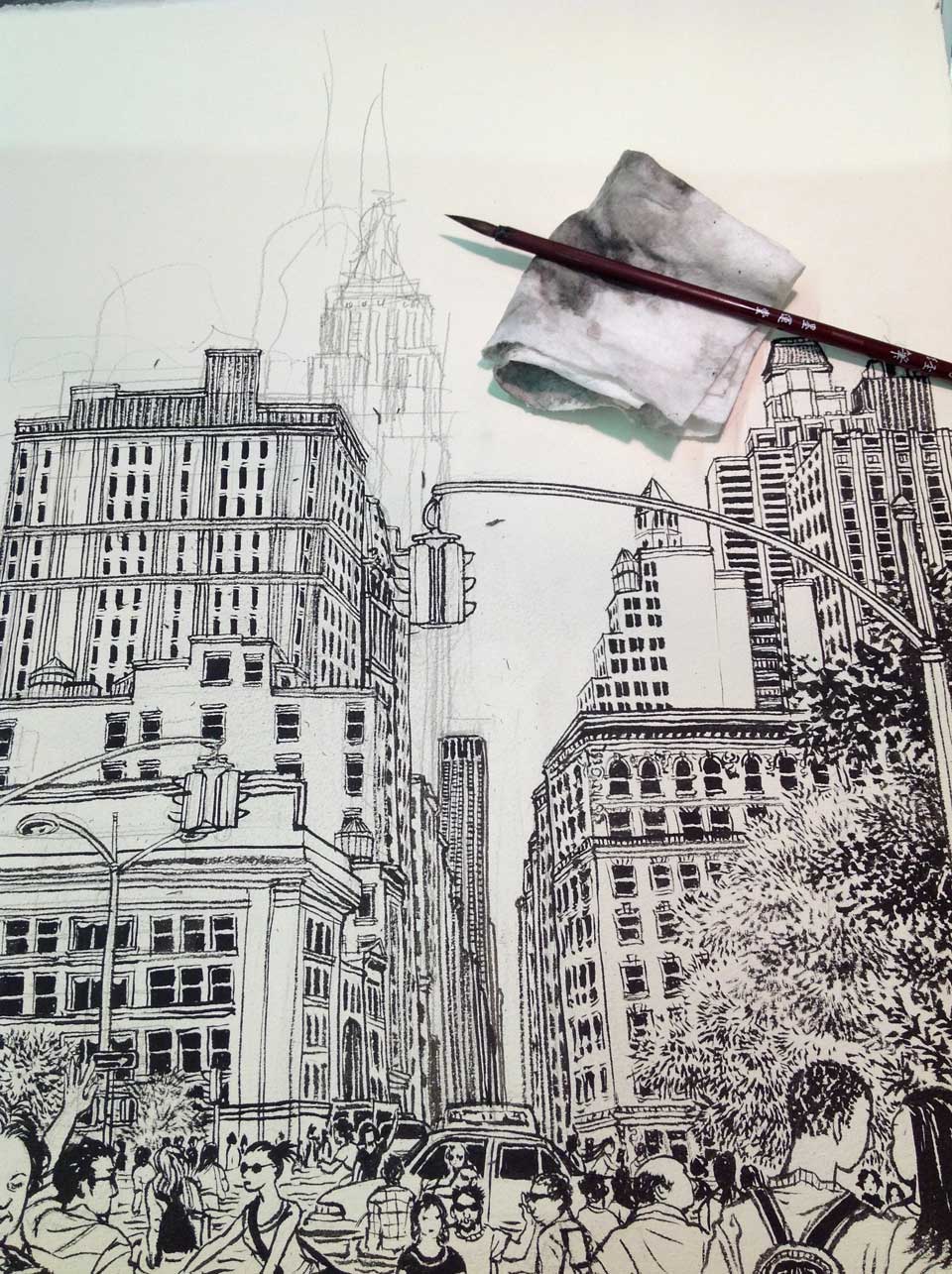
Having all the windows open on my screen, I get to work. I virtually walk around as I draw, according to which part I am drawing.
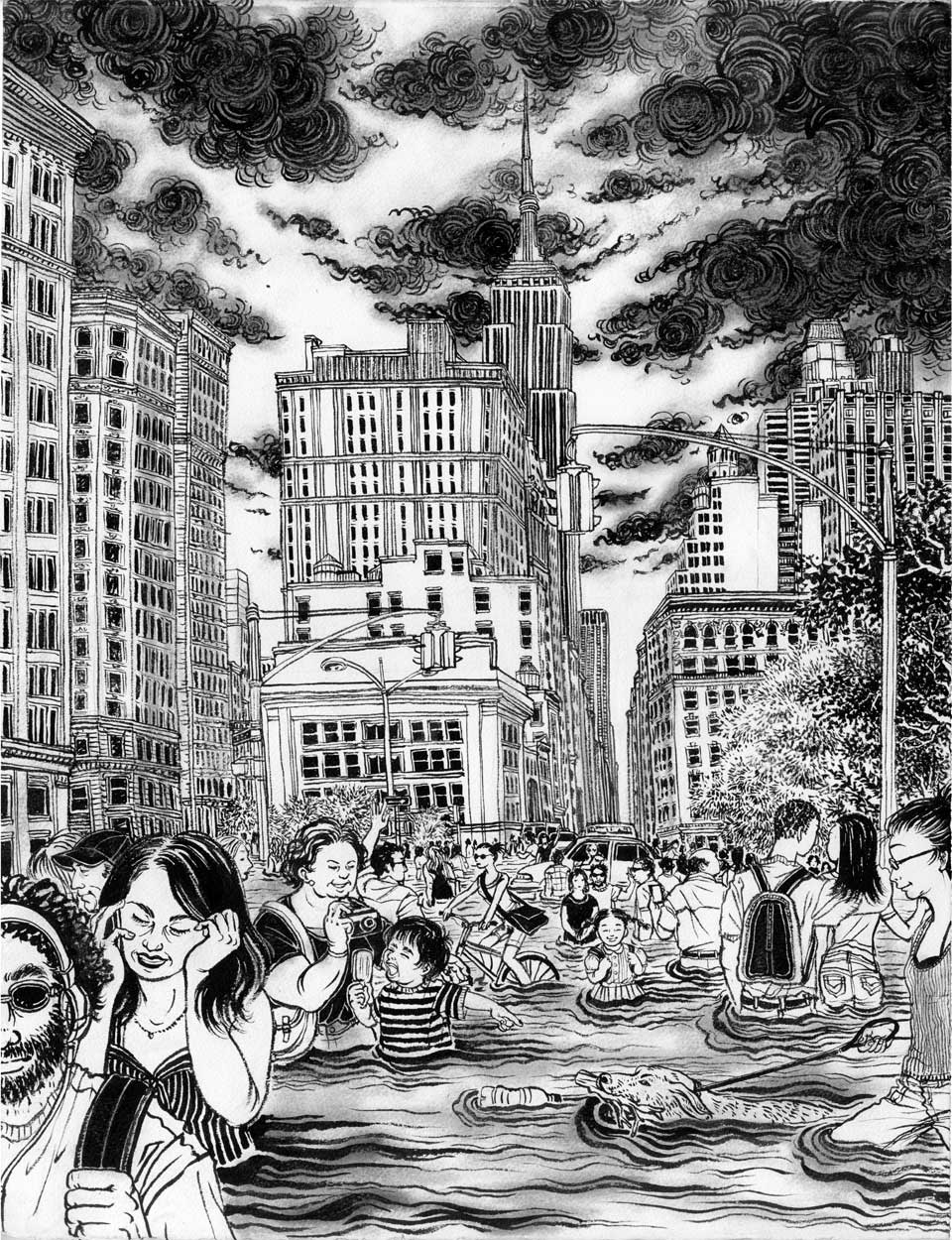
I didn’t mention about the characters in the image, but that was another fun part of this project.
Williamsburg hipster dude listening music on his big headphone, hot girl (but a realistic one and not a movie star kind) talking on her phone, teenage couple, George from Seinfeld look alike… A girl with the dog is based on one of my students who had to give away her dog to the neighbor and feeling sad, so I decided to draw her with a dog happily taking a walk.
And oh, the small girl in the center with backpack is me as a child.
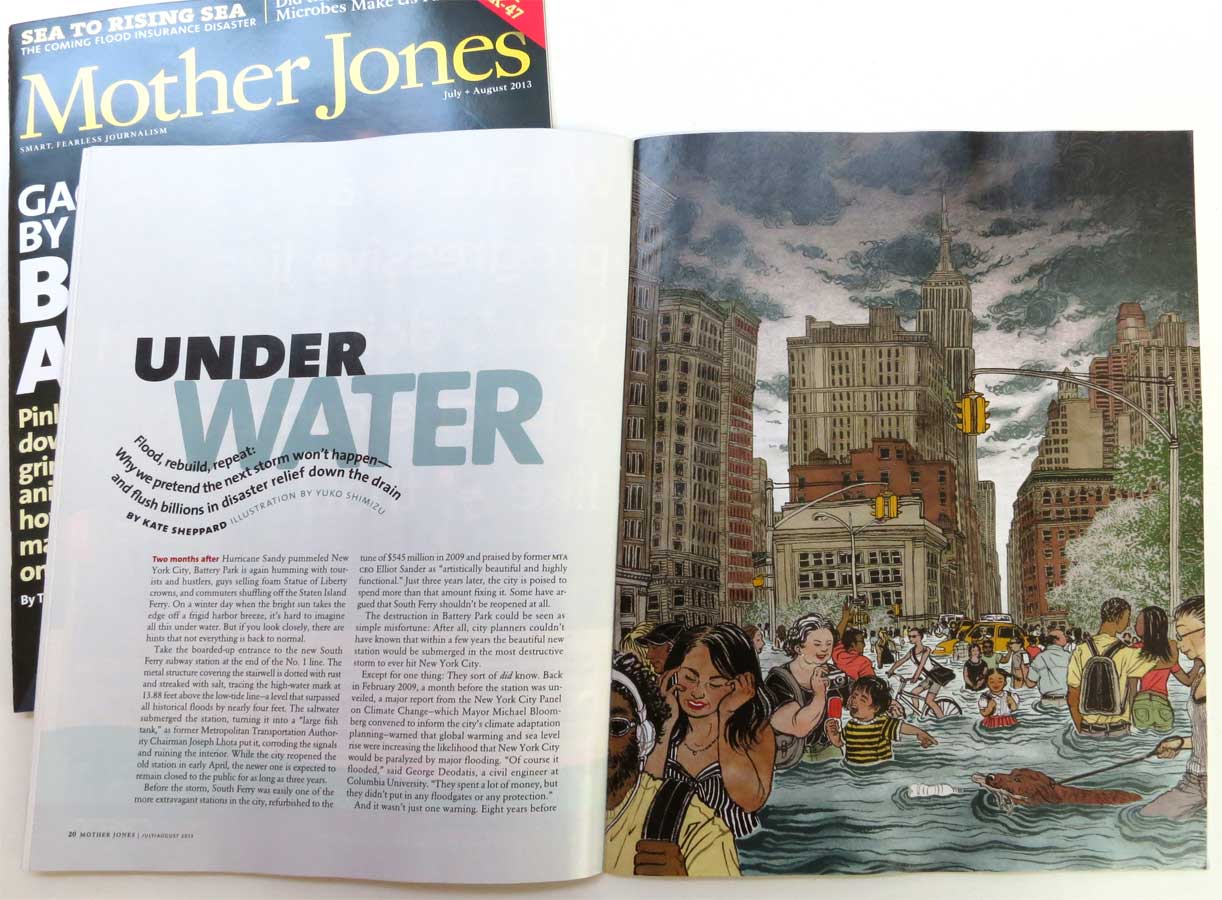 Last but not least, thank you AD Carolyn Perot for this fun project. Mother Jones July/August issue is in newsstands now.
Last but not least, thank you AD Carolyn Perot for this fun project. Mother Jones July/August issue is in newsstands now.
I don’t love getting asked about my artistic influences and inspirations. I had stopped answering the question all together some years ago. The biggest reasoning behind it was because I have lived long enough to the point things that have influenced me at some point in my life often have no relevance to who I am now, though, I may still see those early influences in my work. If I name all the influences, past and present, then my list would probably be as thick as a dictionary.
However last week, comic artist and friend James Hodgkins posted something on Facebook that really got me.
“The Rules: Don’t take too long to think about it. Fifteen Artists who’ve influenced you and that will ALWAYS STICK WITH YOU. List the first fifteen you can recall in no more than fifteen minutes.”
What I loved was this: Artists who’ve influenced you and that will ALWAYS STICK WITH YOU. I really like the idea of narrowing down to the core of influences that will be there, forever.
So, I followed his advise, took less than 15 minutes, and came up with the list. And thought I should share it with you. Because, well, I get this asked a lot, and I haven’t answered.
1. Alexander Rodchenko
He saw and show the world from a completely different viewpoint from people may often do. He has taught us that mundane can turn into extraordinary by creative points of view. Even after so many decades, he still teaches me, photographers and designers of today to see the world differently. (No, that is NOT a Franz Ferdinando album cover.)
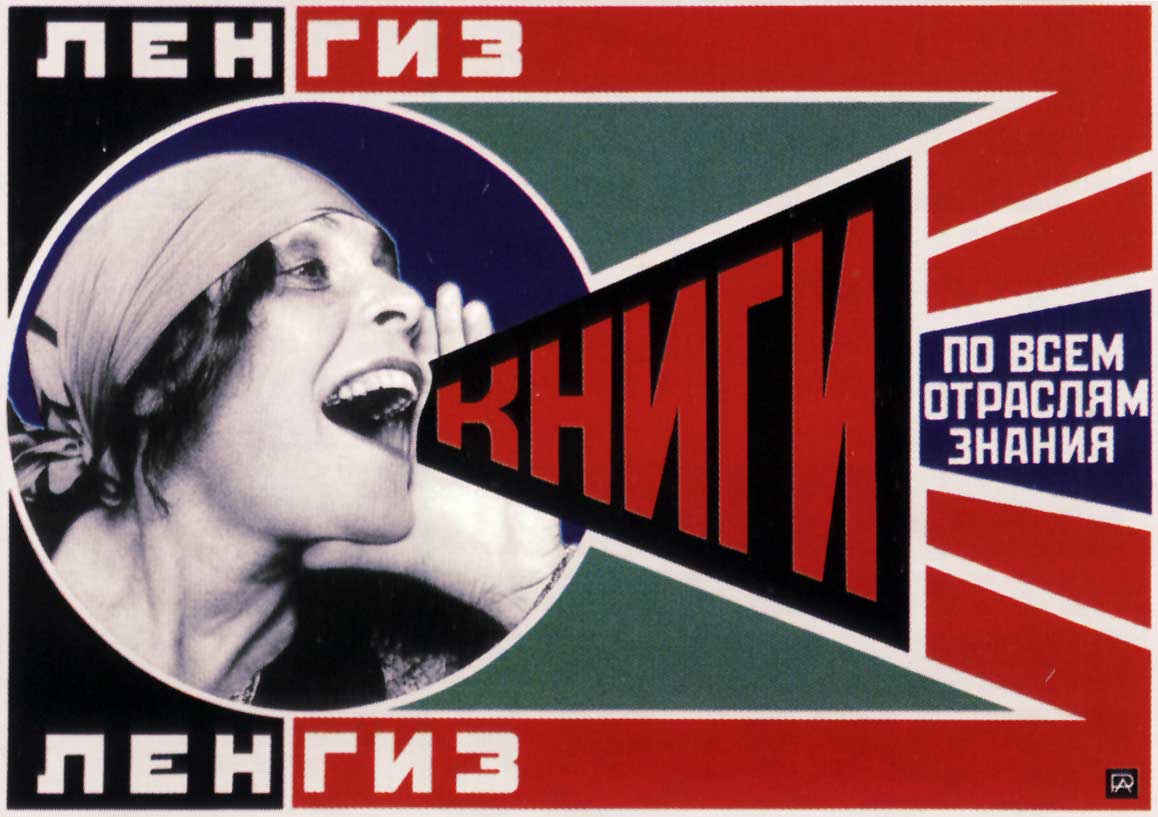
2. Wong Ka-Wai
I first saw ChongKing Express right when I started learning Cantonese in the mid 90s. It was nothing like I have ever seen before. And probably pushed me to keep studying Cantonese for the following three years. Wacky storyline, cinematography that feels like you are drunk or dreaming (done by ultra talented Chris Doyle), and oh the colors! If you had not watched his films, you are missing out. (My favorite is Days of Being Wild)

3. Jean Paul Gaultier
If I have to pick one fashion designer to wear his/her clothes for the rest of my life, Gaultier is probably not the one I will be choosing. But, if I pick one designer who I think has always been coming up with great concepts take risks, and trying to do something new, and being such an inspiration, then that one is DEFINITELY Gaultier. He is not just about Madonna’s cone bra. (Thanks to eBay I have been slowly collecting his vintage clothes I couldn’t afford in the 90s.)

4. Katsushika Hokusai
I first encountered original Hokusais at a retrospective show at a small Isetan Department Store museum in Shinjuku. I was probably 16. They totally blew my mind away. And even till this day, they still do. In case you didn’t know this already, he was the very first person to use the word MANGA.
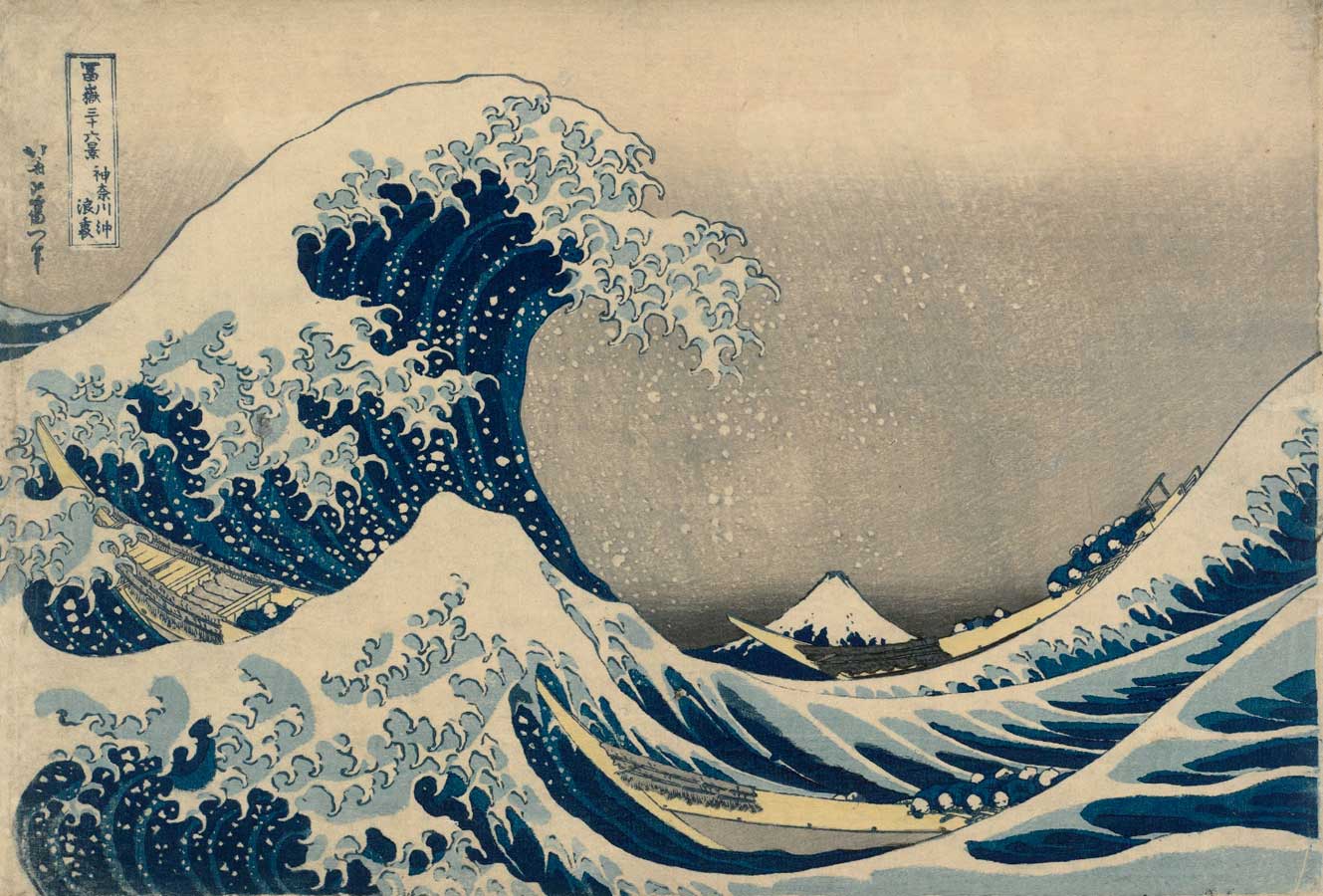
5. Utagawa Kuniyoshi
Hokusai’s strength was ‘everyday pictures’ of people’s lives in Edo Period and landscapes especially those depicting Mt. Fuji.
Kuniyoshi on the other hand was known for his ultra masculine and powerful Musha-E (pictures of the heros / warriors). My love-affair with Kuniyoshi is fairly new, only about ten years or less. I had an assignment to draw a samurai for Rolling Stone Magazine, and I needed a good reference. I went to buy a book, then I got completely hooked. I don’t know how many times I have used that book since.
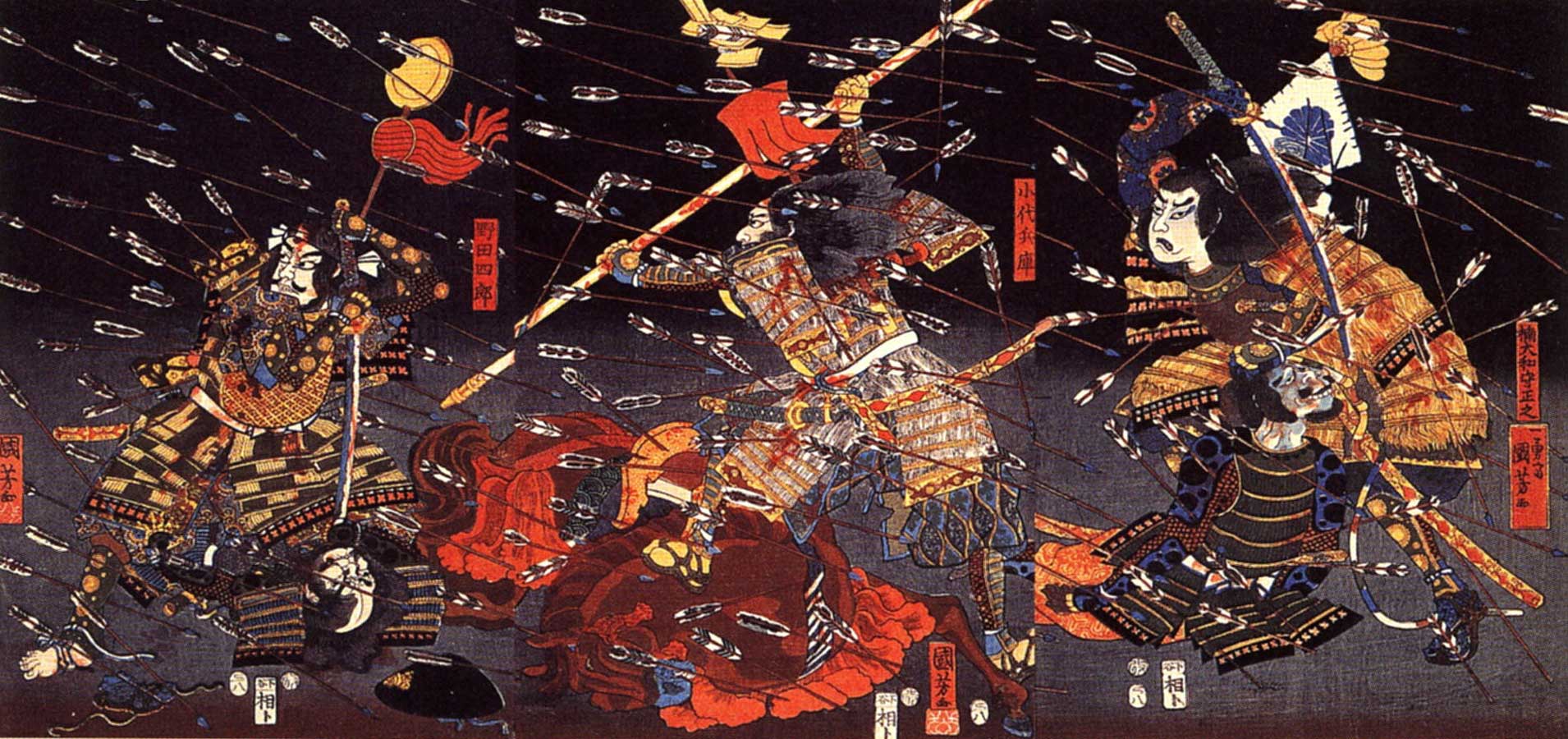
6. Stenberg Brothers
Russian illustrator/graphic designer duo from 1920s to 30s who were known for their striking movie posters. I don’t know how many times I channeled their design, color, and compositions to come up with a graphic solution. Whenever I have to juxtapose multiple images in one picture, channeling the brothers always work.
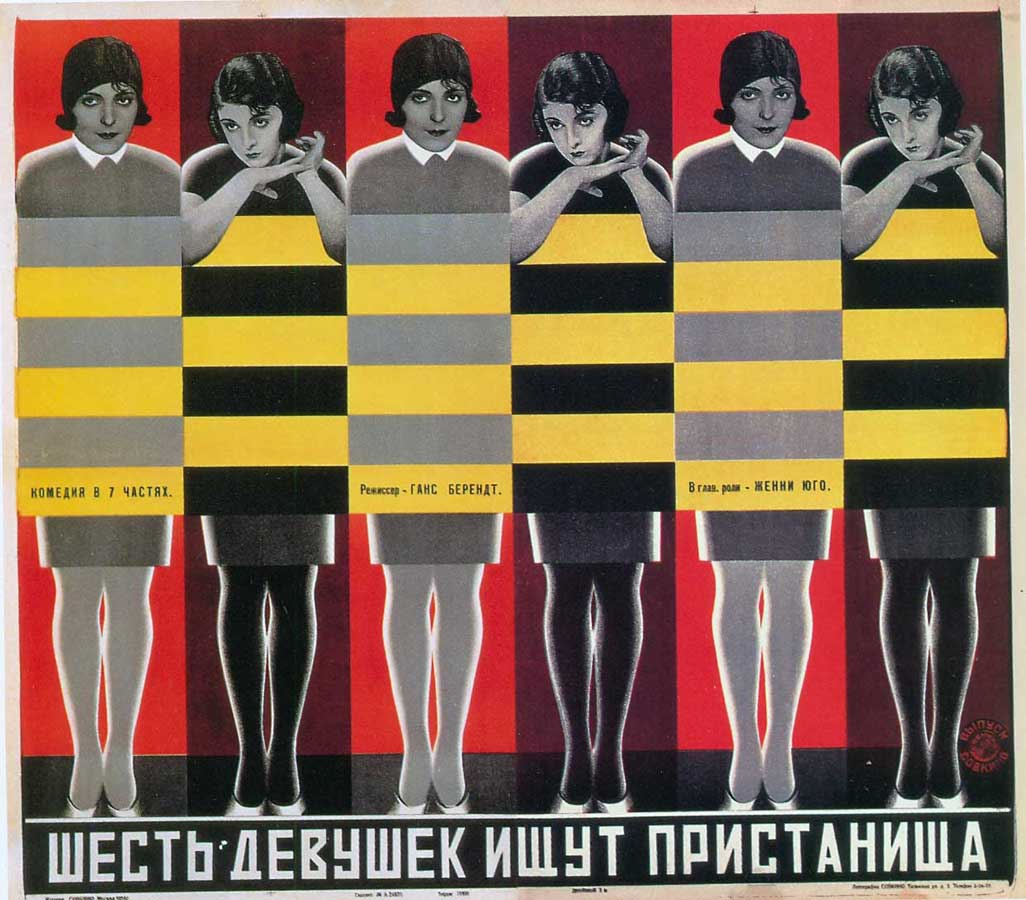
7. John Woo
Even if the only movie he has ever made was 英雄本色 (A Better Tomorrow) he is still on my list. Thank you John Woo.

8. Haruki Murakami
I am not sure non-Japanese readers of his books know this fact, but his books became popular in Japan initially for sort of odd (in a good way) writing style that reminded us of translated foreign fiction. It was nothing like we had known. And he remains the same. I had always believed there is no space for magic left in Tokyo, because it is such a logical place. Then he deceived me with Hard-boild Wonderland and the End of the World. He has been deceiving the readers throughout the years (in a good way).
And, oh, these beautiful American edition covers by John Gall! (And, I am still dreaming of one day vacationing in that unknown island in Sputnik Sweetheart)
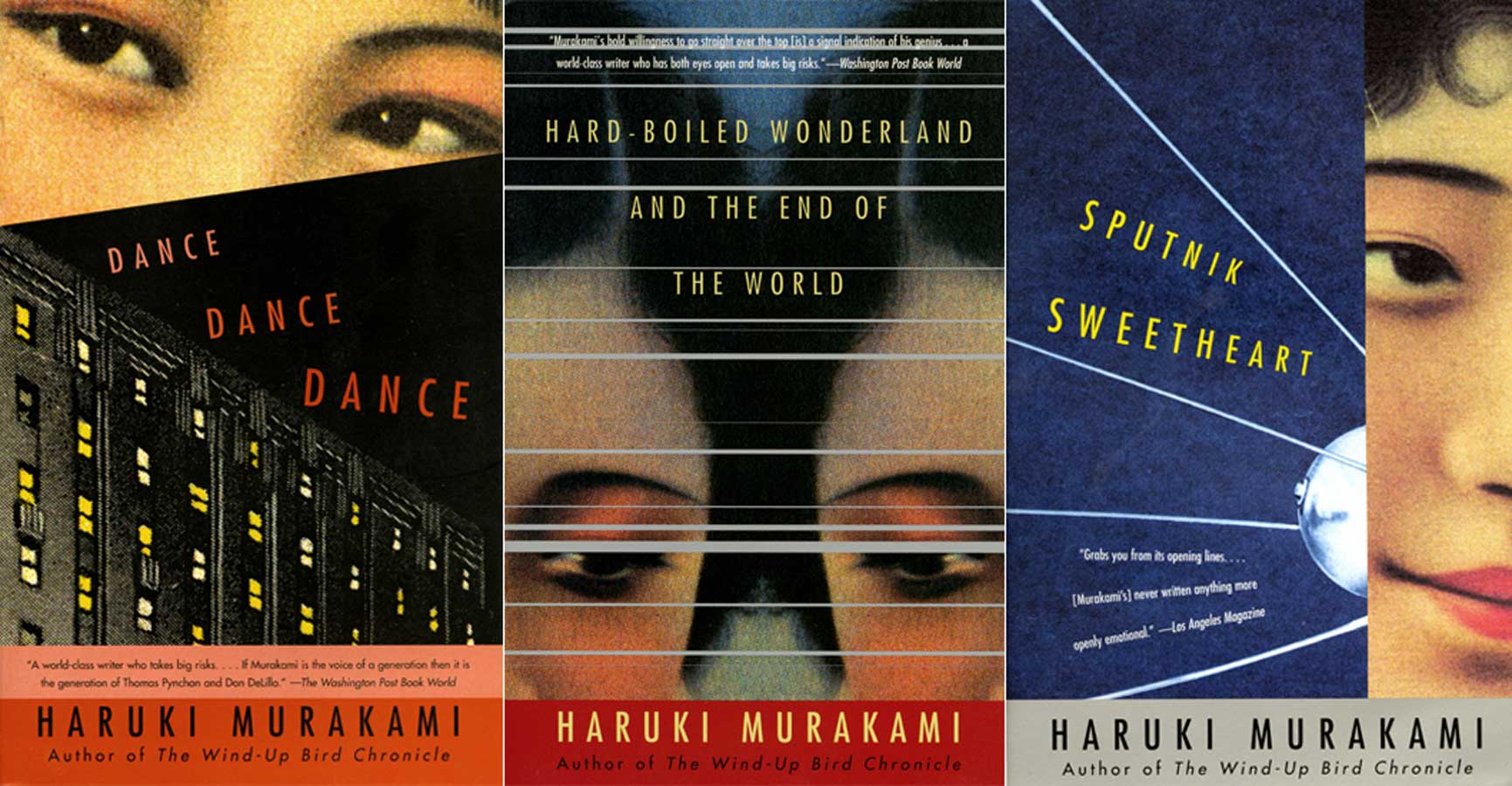
9. Yukio Mishima
This is my very personal opinion, but if you allow me to say, he is one of the last of the truly Japanese Japanese writer. It is hard to believe he ran through his life so fast, so prolific, and gone so quickly. He wrote this amazingly detailed psychology of an old man at the end of his life, when he was in his 20s (Forbidden Colors). Psychology so real it is hard to believe he was so young. (I love everything about his books, but NOT his political viewpoint.)
And, thank you John Gall for hiring me to do one of his book covers. It was the best present. (book not yet published)

10. Björk
Need I say more??
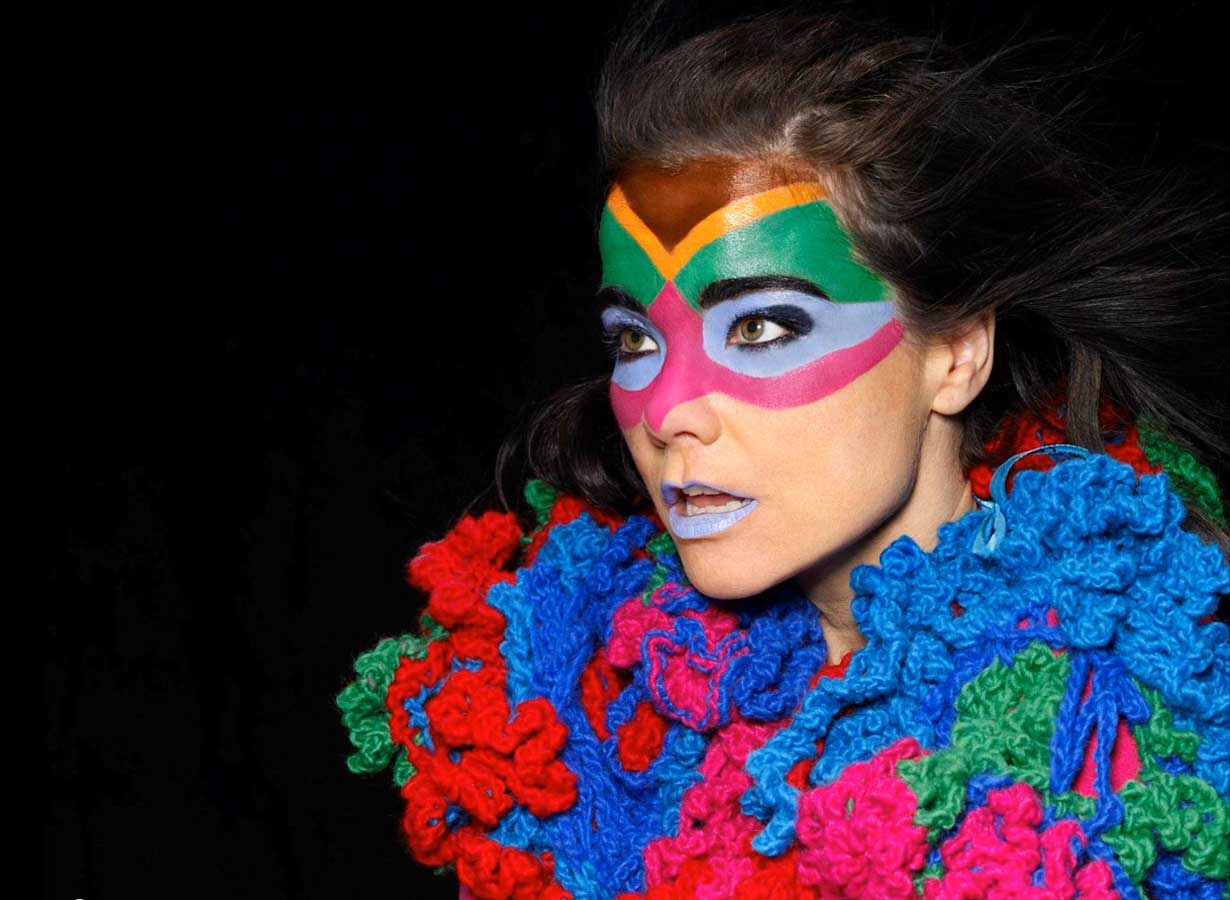
11. Matthew Barney (specifically Cremaster Cycle)
I was a Sci-Fi and fantasy geek growing up. Then I grew out of it. Then I met Cremaster Cycle. It was cooler than any fantasy I have ever seen, read, and drooled.
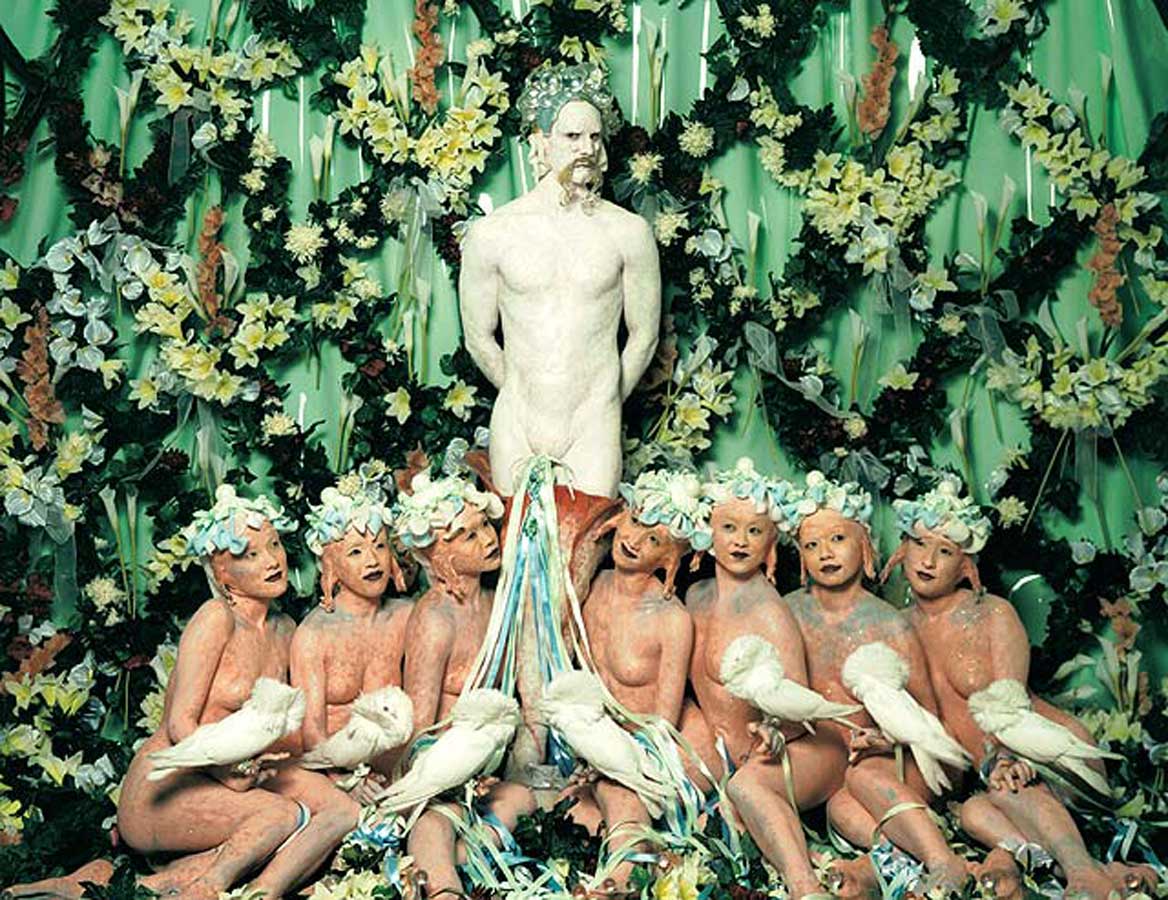
12. Jean Cocteau
He was the true Renaissance Man. He made movies, he wrote books, he drew and painted, and even one of the most popular rings from the high-end jeweler Cartier was designed by him. He was truly the original. (OK, I have to confess I haven’t seen many of his movies. I got into his artwork by his paintings, drawings and books.)
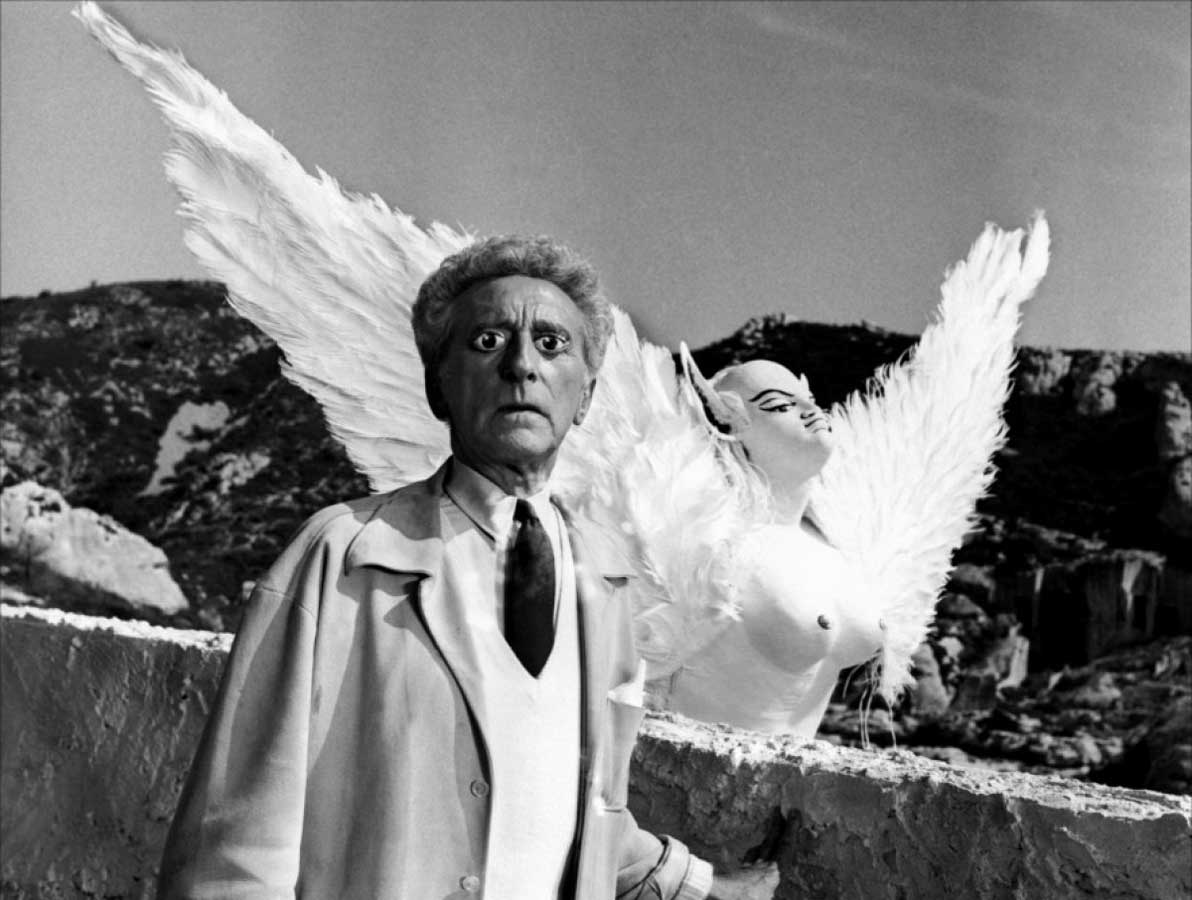
13. Paula Scher
Ms. Scher, I am not a stalker, and I am not a lesbian either (and neither are you), but I once said to a friend I want to marry you. I love your design, but I love your brain even more. Thank you for putting Make It Bigger out in this world.
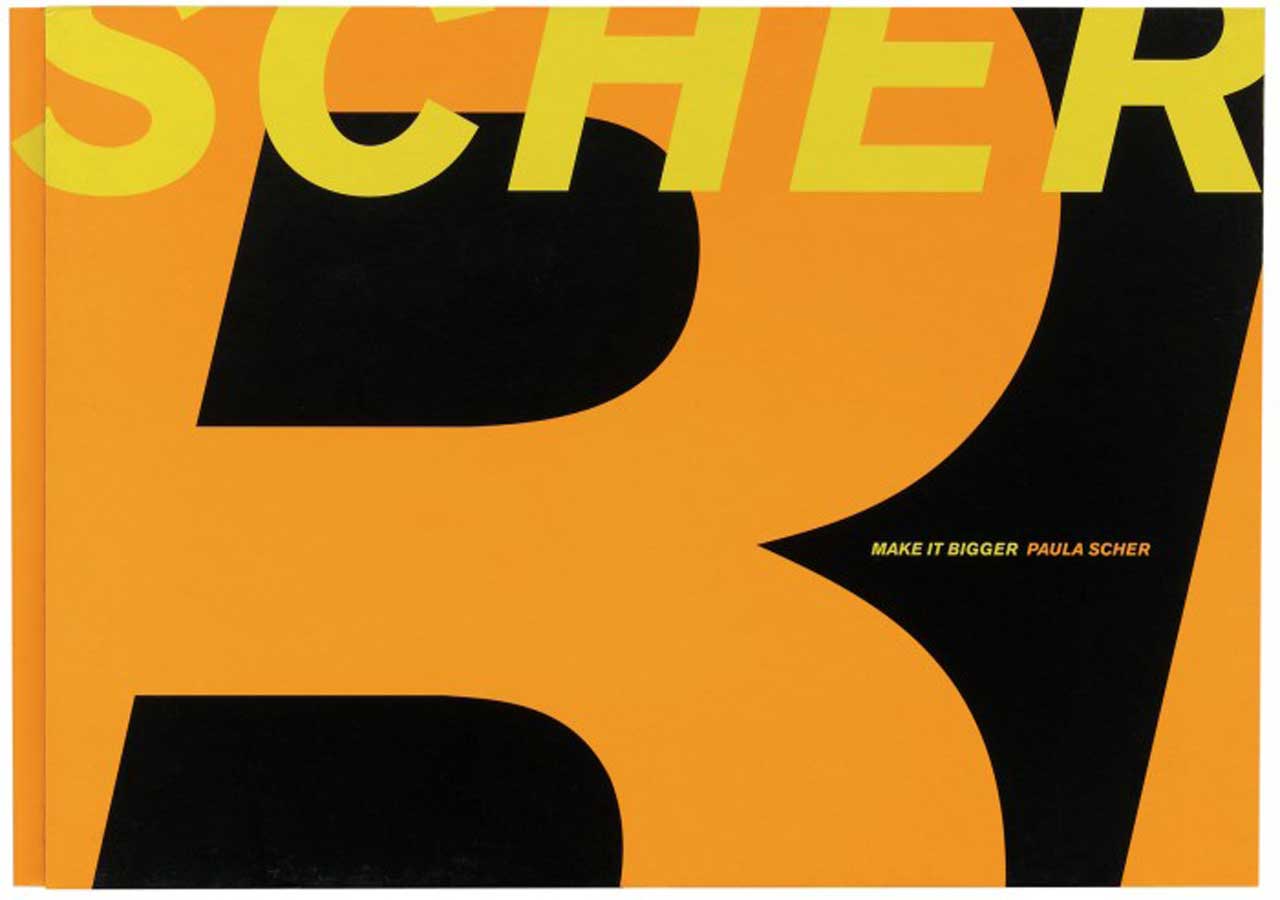
14. Miyata Masayuki
Also when I was about 16, I fell in love with the paper-cut art by Miyata Masayuki. He had a new image every day in Asahi Shinbun, a major national paper of Japan to accompany a daily novel Eight Dogs Tale written by Futaro Yamada. I used to cut out the images and collect them. While most of the early influences look very faded and juvenile looked through the eyes of an adult self, his works still look fresh and striking. So, I needed him on the list.
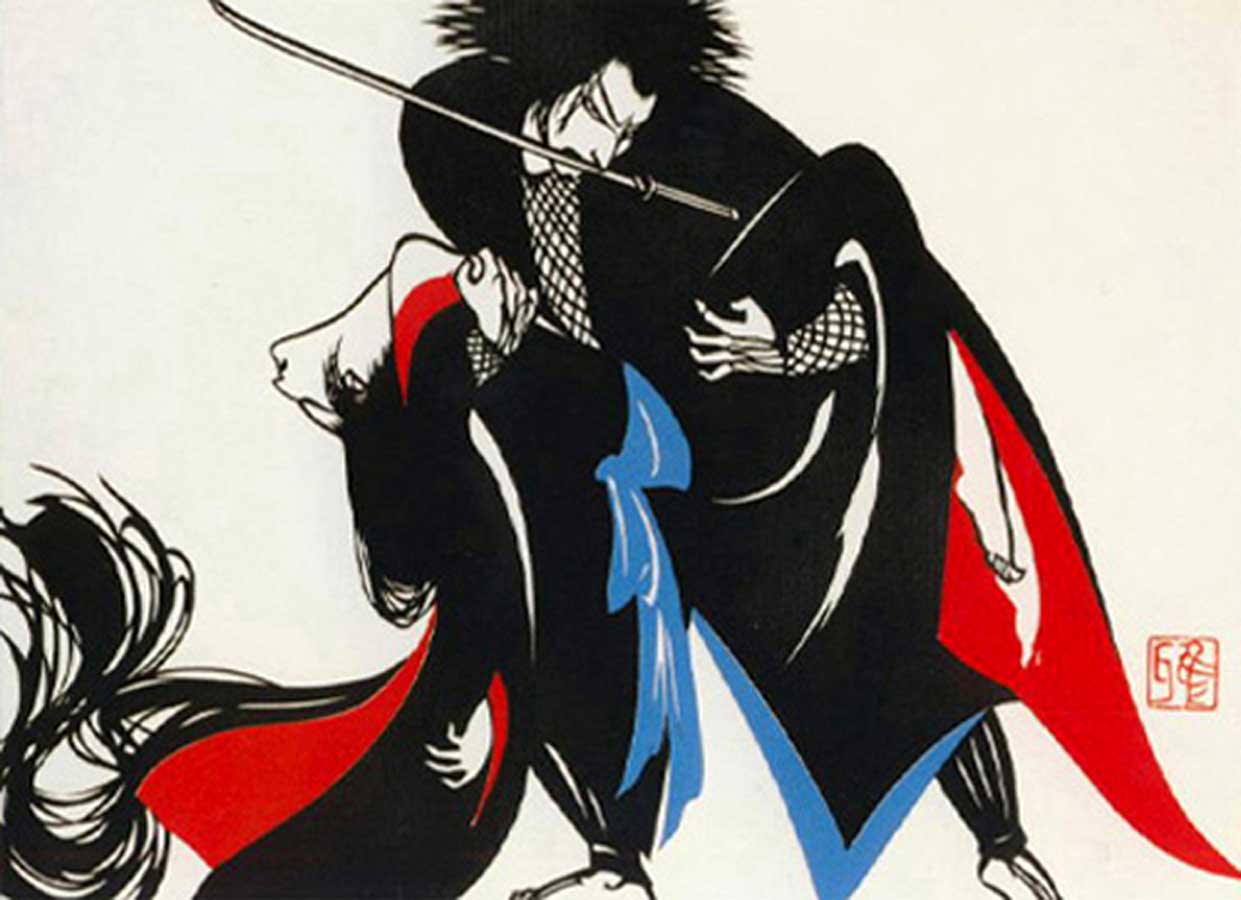
15. Pierre Cardin
I am the child of the ‘space age’, and every so often, I get reminded that my earliest childhood memories (Apollo 11 moon landing, etc) still affect who I am, what I am attracted to, and my visual aesthetics subconsciously Cardin for me represent that time period, with his space age designs from late 60s to early-early 70s. 
What’s your 15?
One of the best things about illustrating for magazines is that I learn new things every day by reading articles I illustrate.
I guess I can say I am climate-change-conscious, seeing my home country of Japan having gone through dramatic temperature change since the mid-late 1980s. (I am not a specialist, but my guess is because it is an island country with many warm and cold sea currents meeting there, the country is especially prone to climate changes. You can ask me about it next time I see you if you are interested in discussing about this more. ) Also recent Sandy hitting NY, my current city of residence, really hard.
But still, reading an extensive article about the next generation of city planning through Green Source Magazine was an eye opening moment.
And, drawing a dynamic opener spread for this was such a fun assignment. Especially that I love drawing sea and waves (I have in past mentioned that I have severe hydrophobia), it was so much fun.
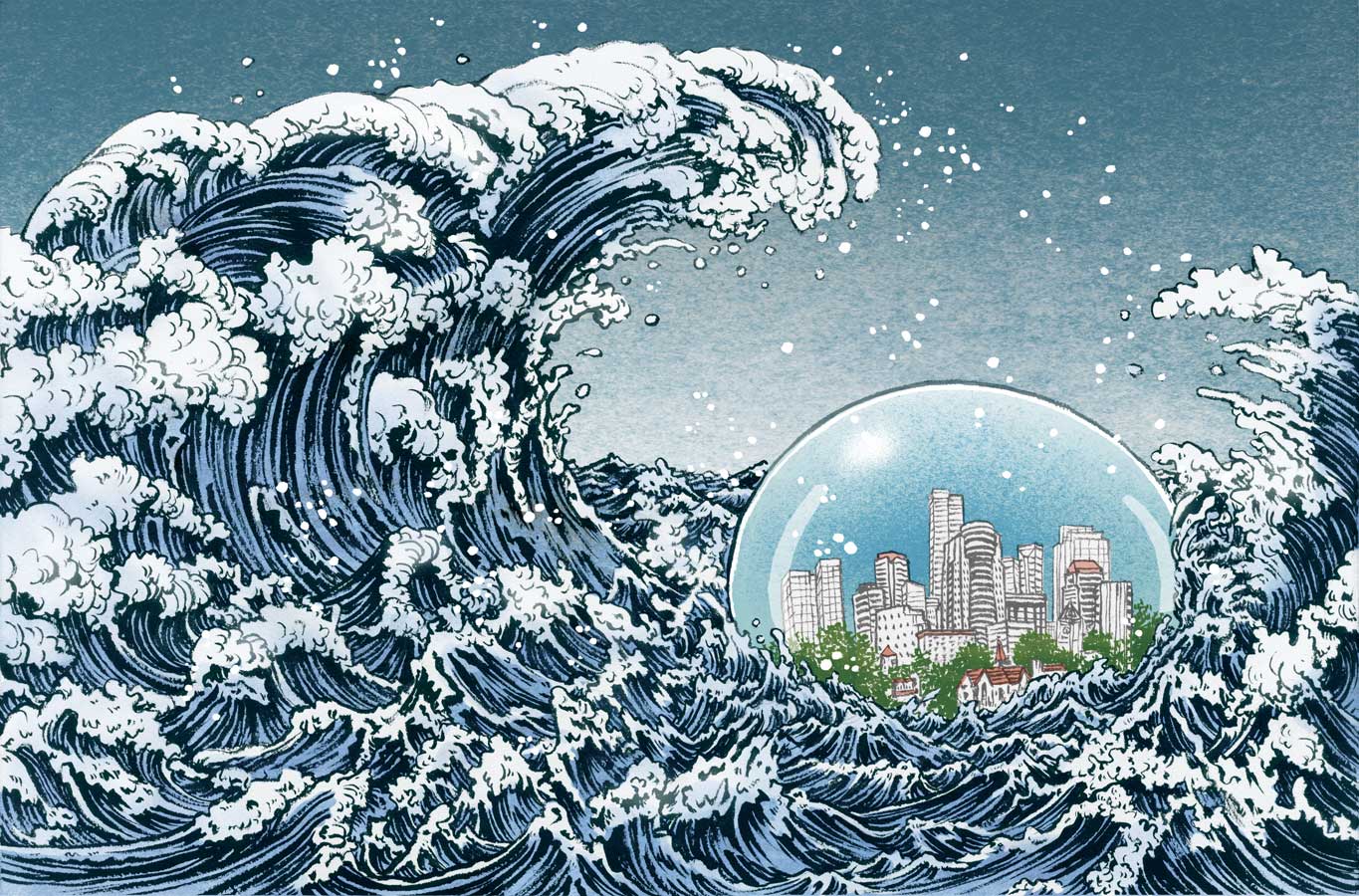
These are three ideas I initially submitted. Honestly, I could have gone with any one of them. Different types of water I can get absolved into drawing…

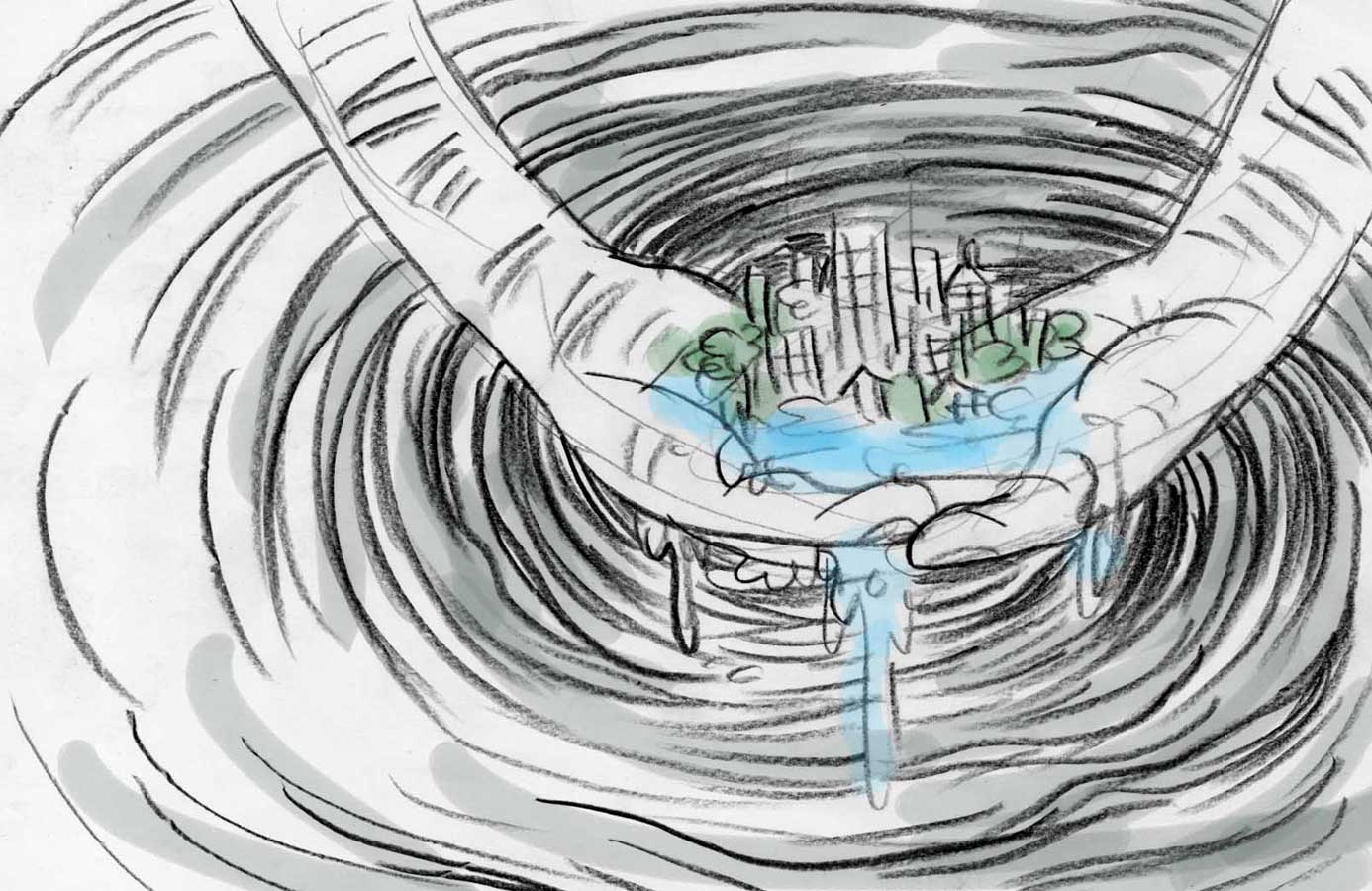

Then, AD Heather Haggerty and I went into minor details to change, based on the rough layout she made. Make sure the orb is not touching the gutter, so make it a lot smaller. waves can be bigger as long as it won’t cover the general type area… I like when ADs are upfront about their needs.
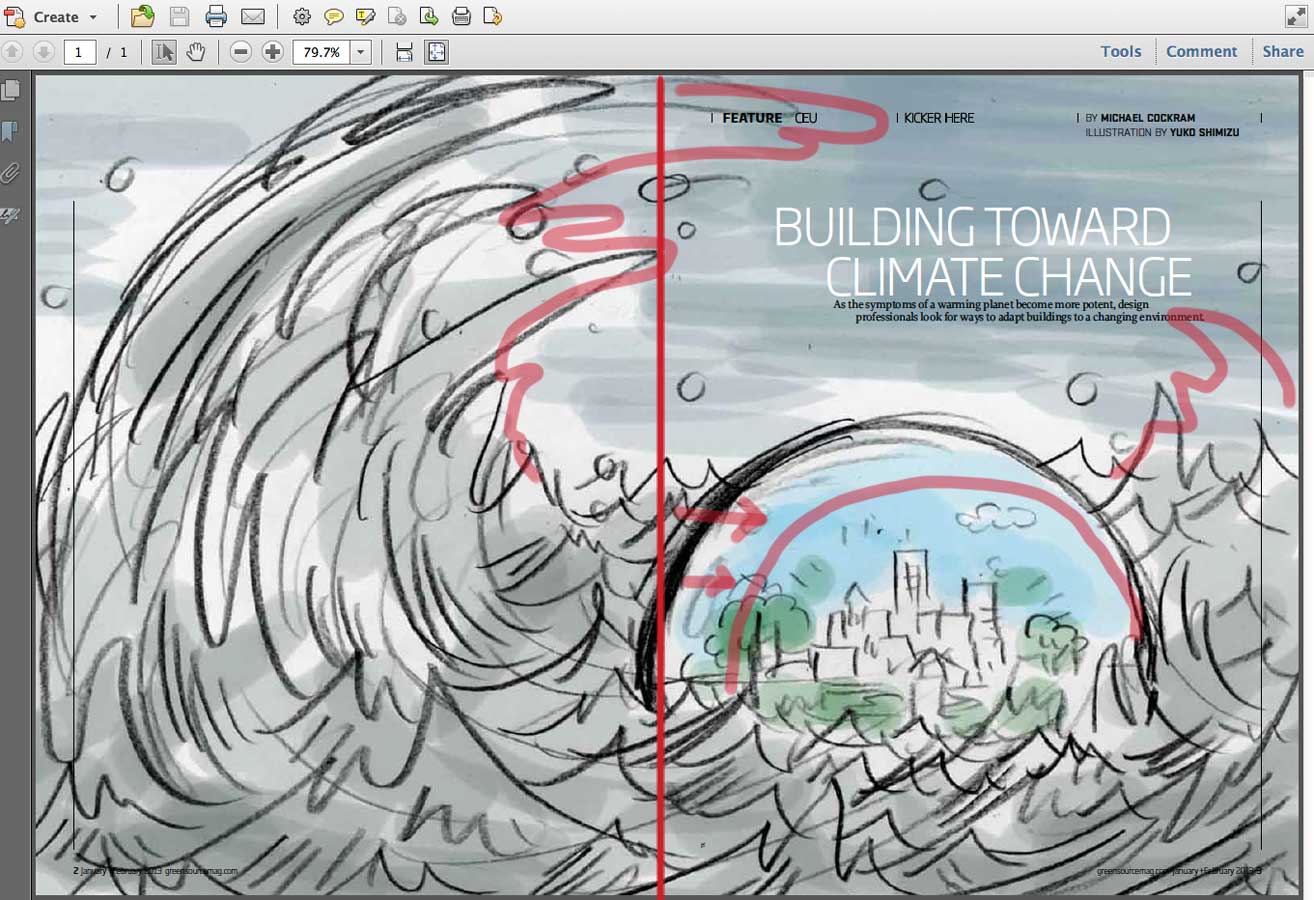
Then, going into drawing…. I have decided this illustration should be about drawing of menacing waves, so most of my time should be spent on actual drawing, with relatively simple coloring process on Photoshop. In the second photo, you can see I marked the gutter area with pencil, so I make sure nothing important sits around that area in final drawing.
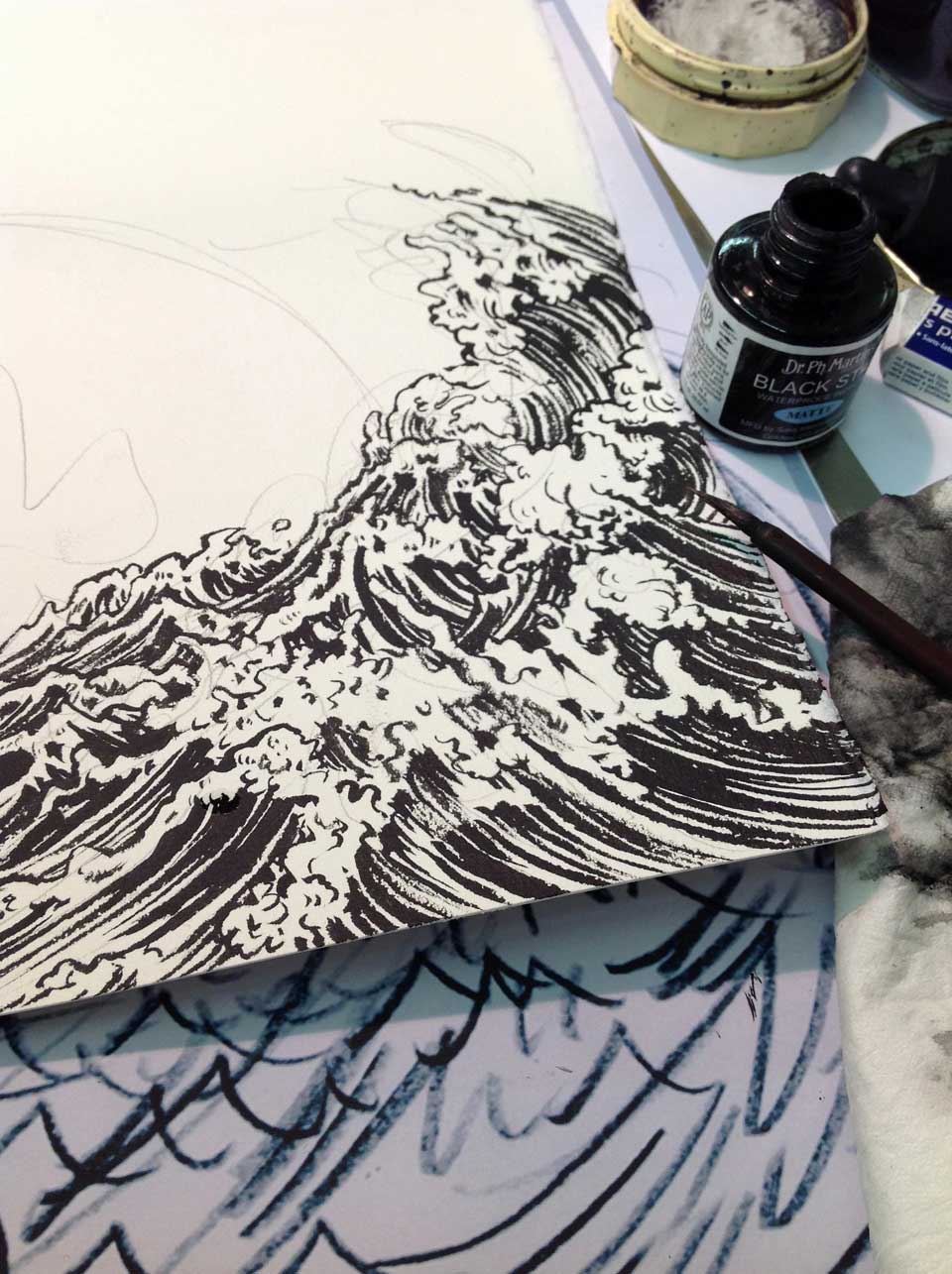
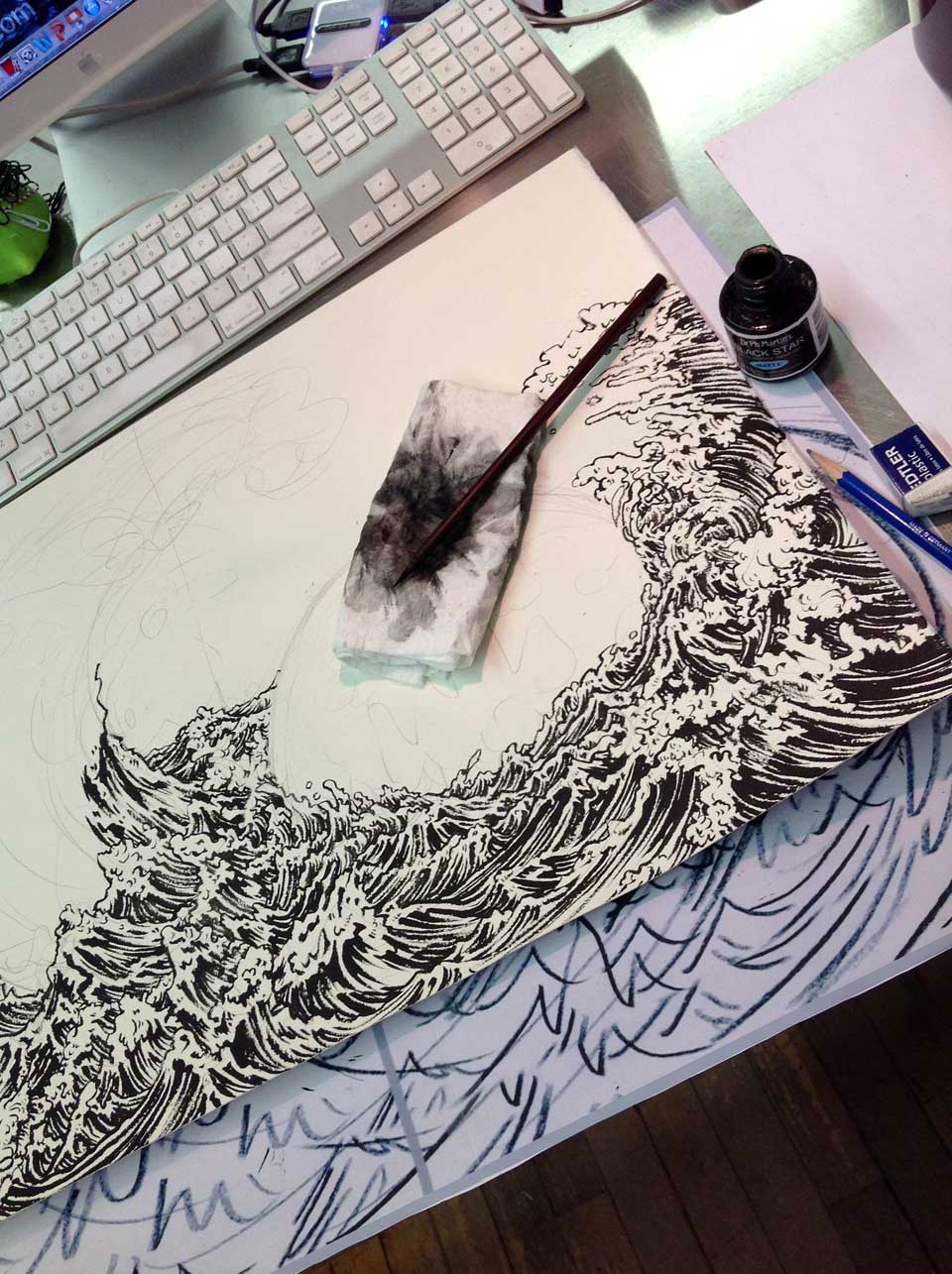
This is a screen shot of some of the reference materials I picked up here and there from different sites. It is not about copying one photo, or two photos. It is all about understand the structures and forms of the subject I am illustrating. So I usually try to look at as many different materials as possible.
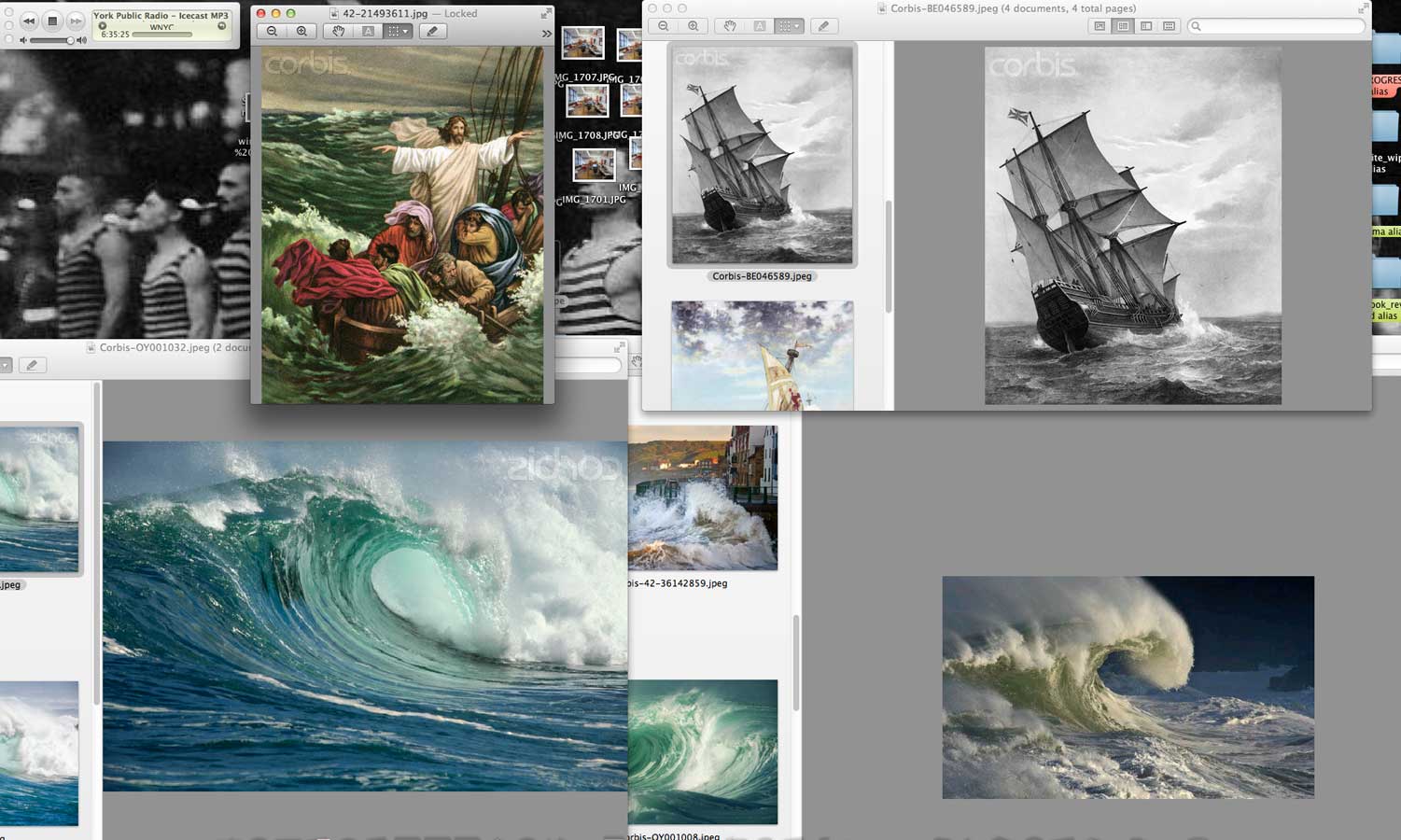
Photoshop coloring process was realatively simple for this project. (I normally have gozillion layers. All the layers fit in this screen shot, so that explains how simple this was. )
On average time divided between drawing and photoshop is 50:50. In this specific project, it was more like 70:30. When drawing is more detailed, I keep coloring simple. When drawing is simple, I end up spending more time coloring. I personally prefer spending more time on drawing than coloring. Drawing is all the fun of my process, coloring is just work. It varies from an artist to artist. Some of my peers enjoy being on the computer much more than going through traditional process. There is no right or wrong, whatever works works.

One of the things that happened with this specific job was to color adjust according to the paper it get printed on. The original finish, which I liked, was too dull to be printed on a recycled paper. So, two stages of minor color adjustments were made. The last one is the final printed image, but in actuality, because of how ink sinks into the paper, the middle one is how it looks on the page. This is something I have to learn and adjust according to each surface. On a slick and glossy paper, the last one may be too bright.
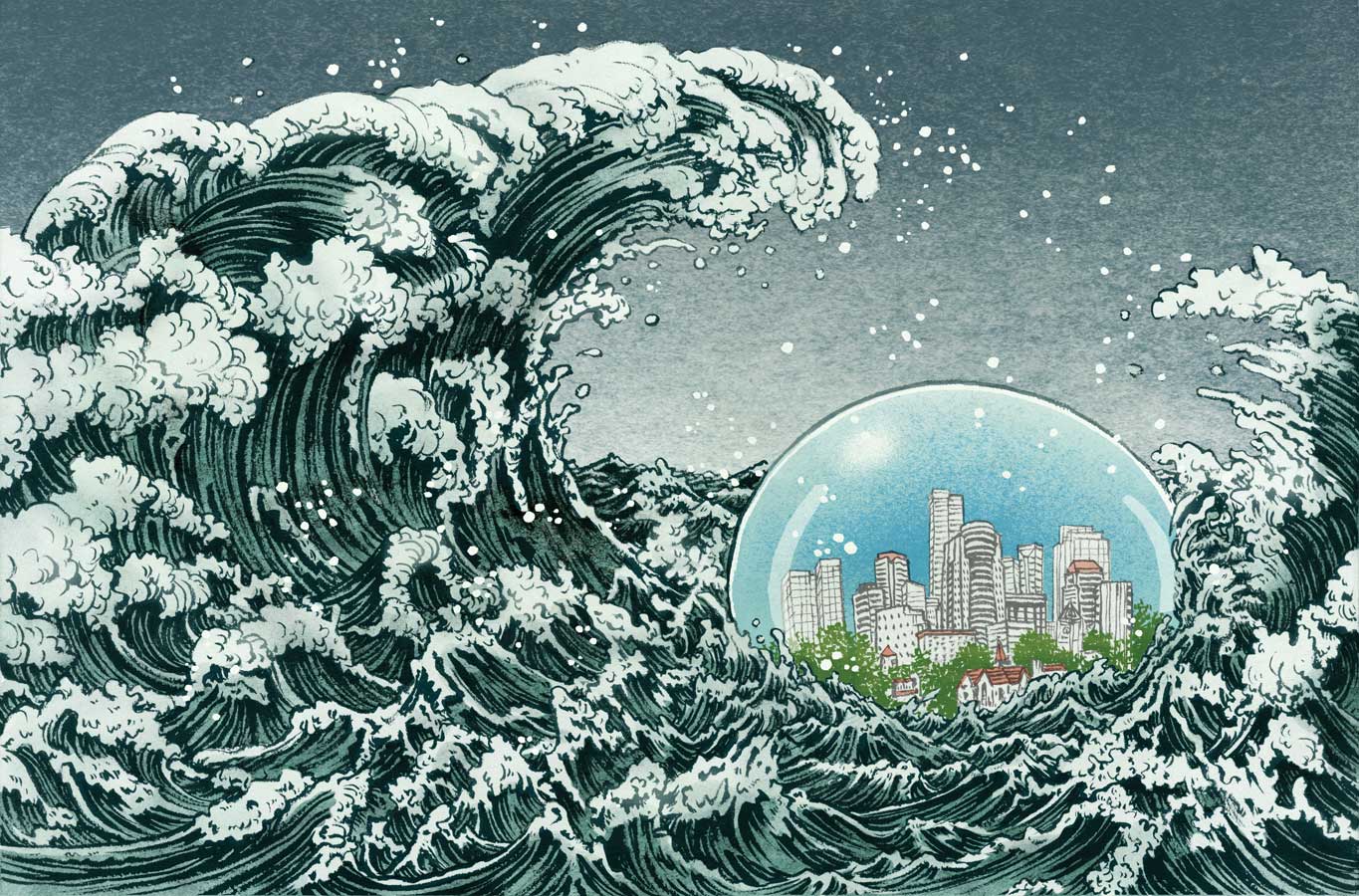

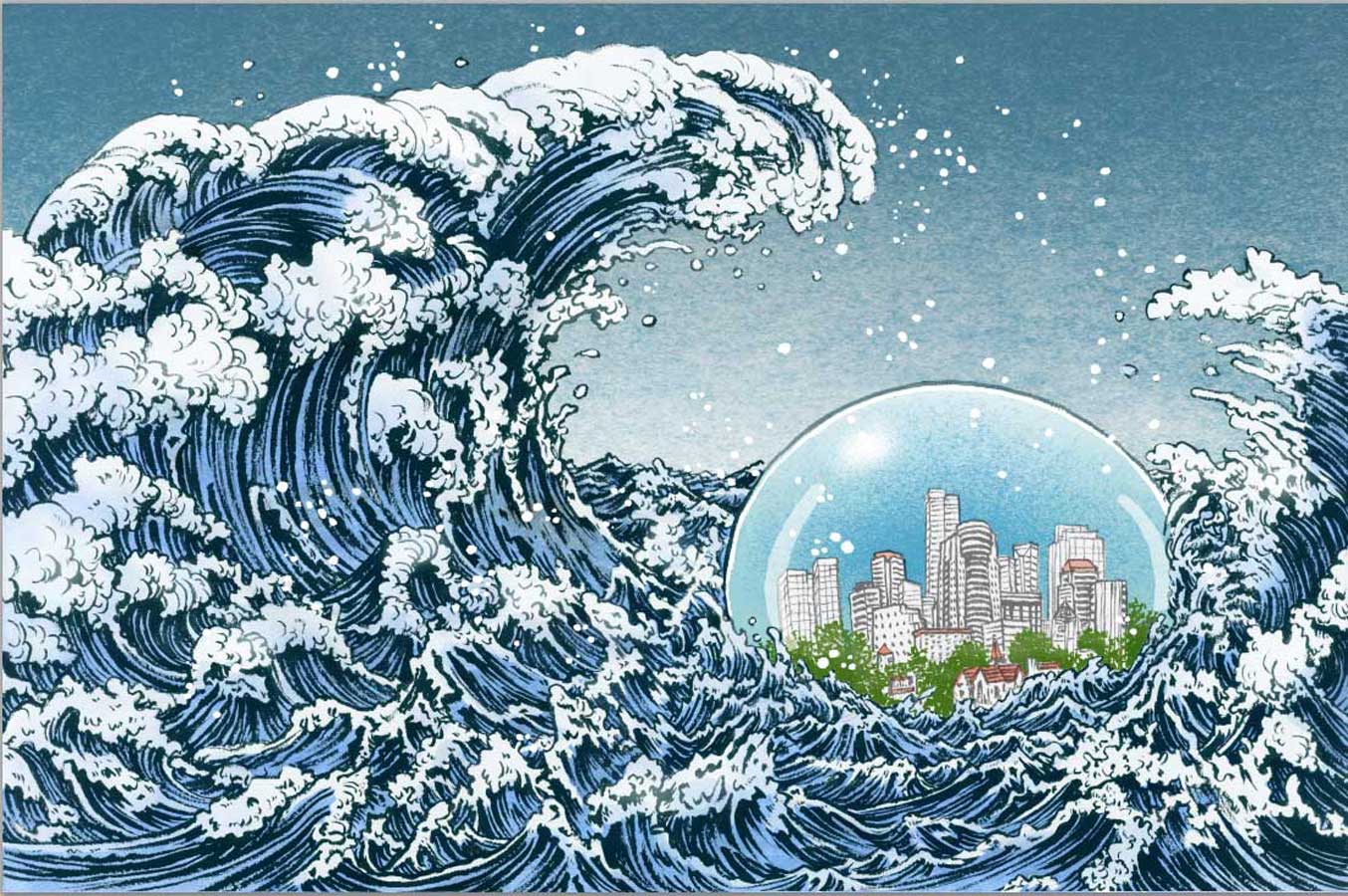
This is the final layout.
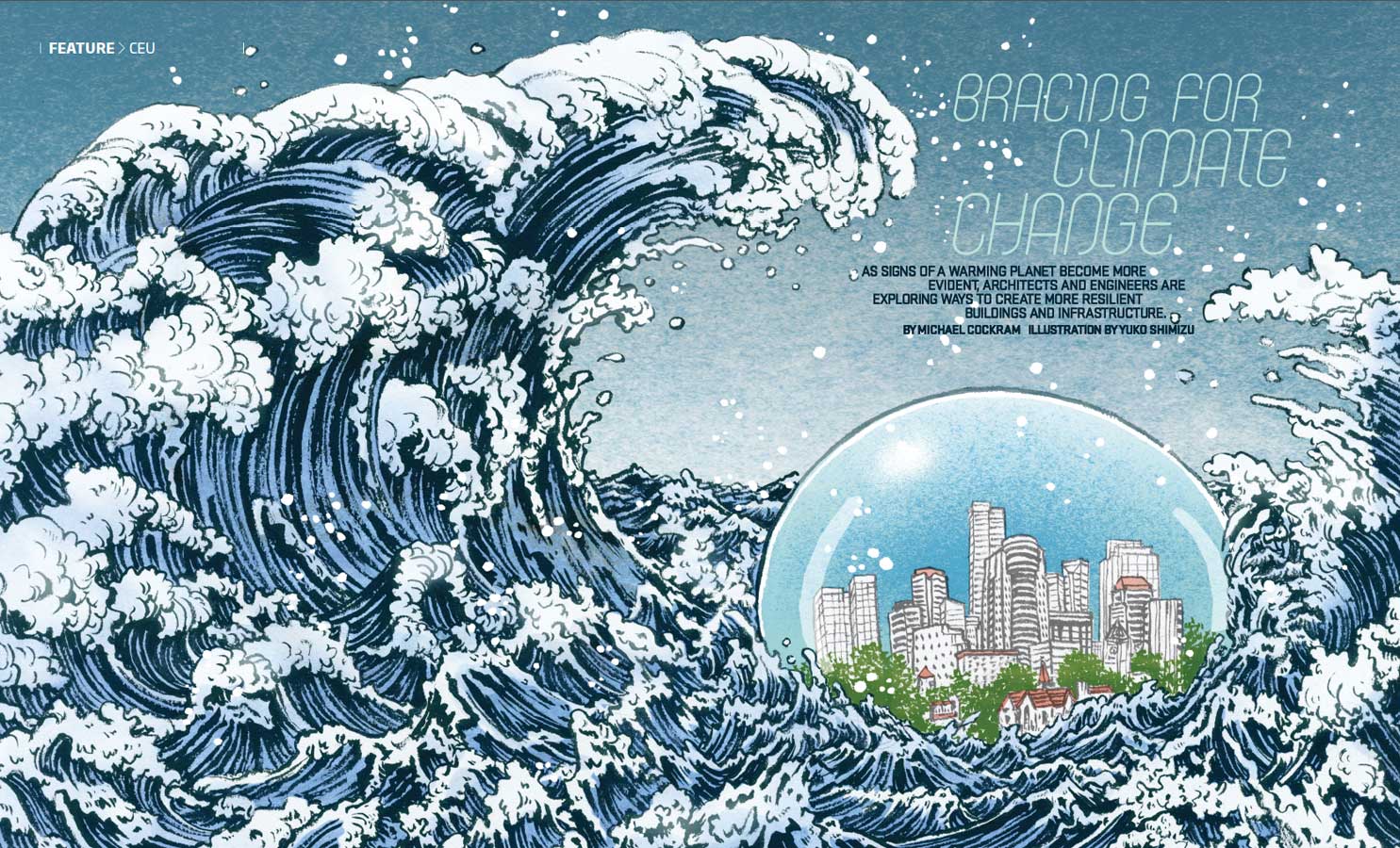
… and in the magazine context. Really good magazine. Cool cover too.
Thank you Francesca Messina and Heather Haggerty for this project.
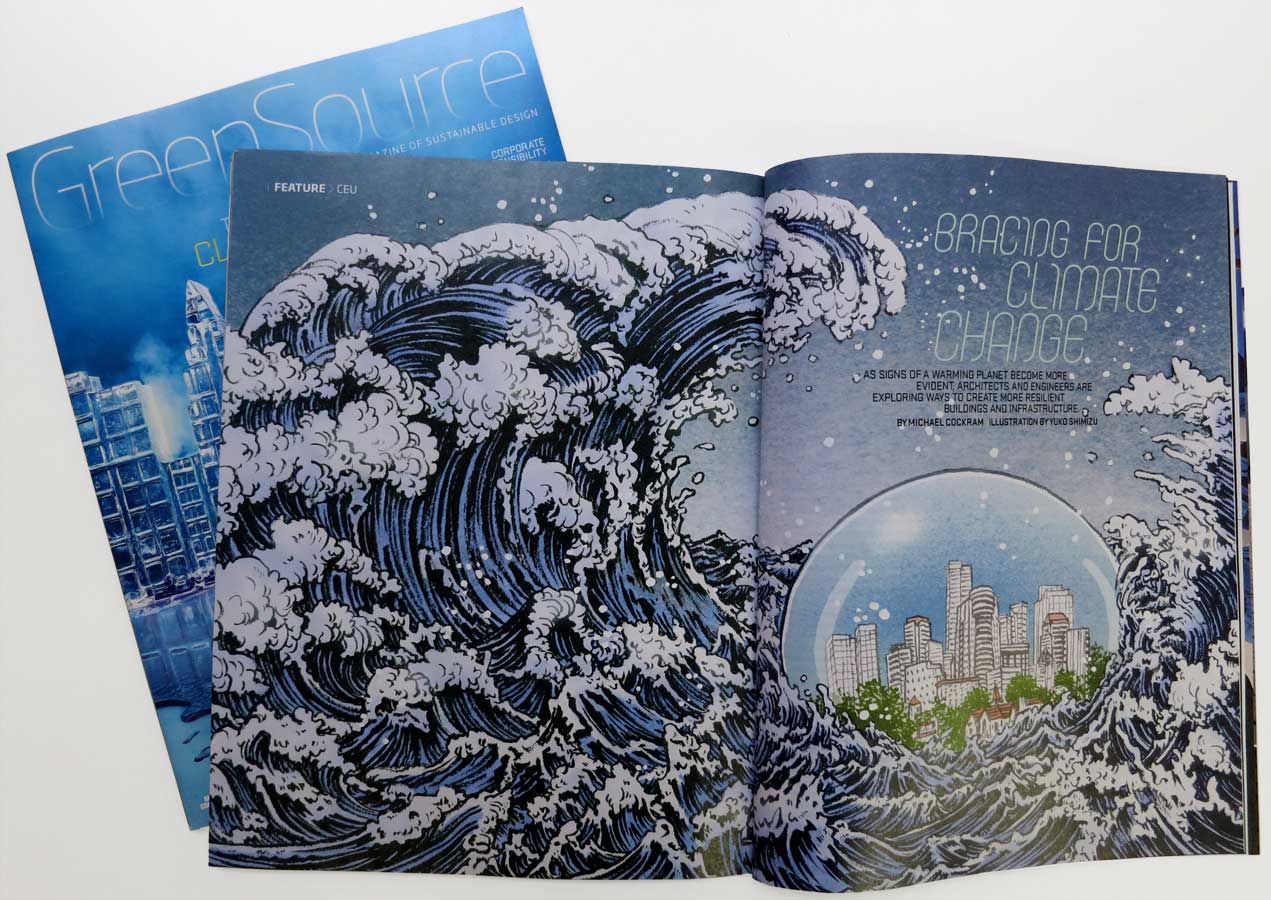
You may, or may not know about Sketchtravel. But, let me tell you that this is quite an amazing project that started relatively small, as something fun, and ended up becoming something of a monster-size charity project.
In 2006, project was conceived and organized by Dice Tsutsumi and Gerald Guelai as a fun small project, let’s pass a sketch book around from illustrators to illustratos, around the world and fill the book cover to cover. It took 4 and half years till the book was complete, contributing artists including: Hayao Miyazaki, James Jean, Peter DeSève, Taiyo Matsumoto, Tomer Hanuka, Mike Mignola, Katsuya Terada, Natalie Ascencios to name a few. Resulting in publishing of the book in multiple language editions and becoming a bestseller in France and Japan, traveling exhibitions, and most importantly, auctioning off the original book and raised 70,000Euros to fund Room To Read to build libraries in five countries so far.
Traveling exhibition is arriving to Kyoto International Manga Museum in Kyoto, Japan in March.
As a contributor to Sketchtravel, I was honored to be asked to create poster for Kyoto exhibit. I took detailed record of creative process, so I am sharing them with you today. I often get asked about drawing medium and surface. For details of medium, please visit FAQ section.
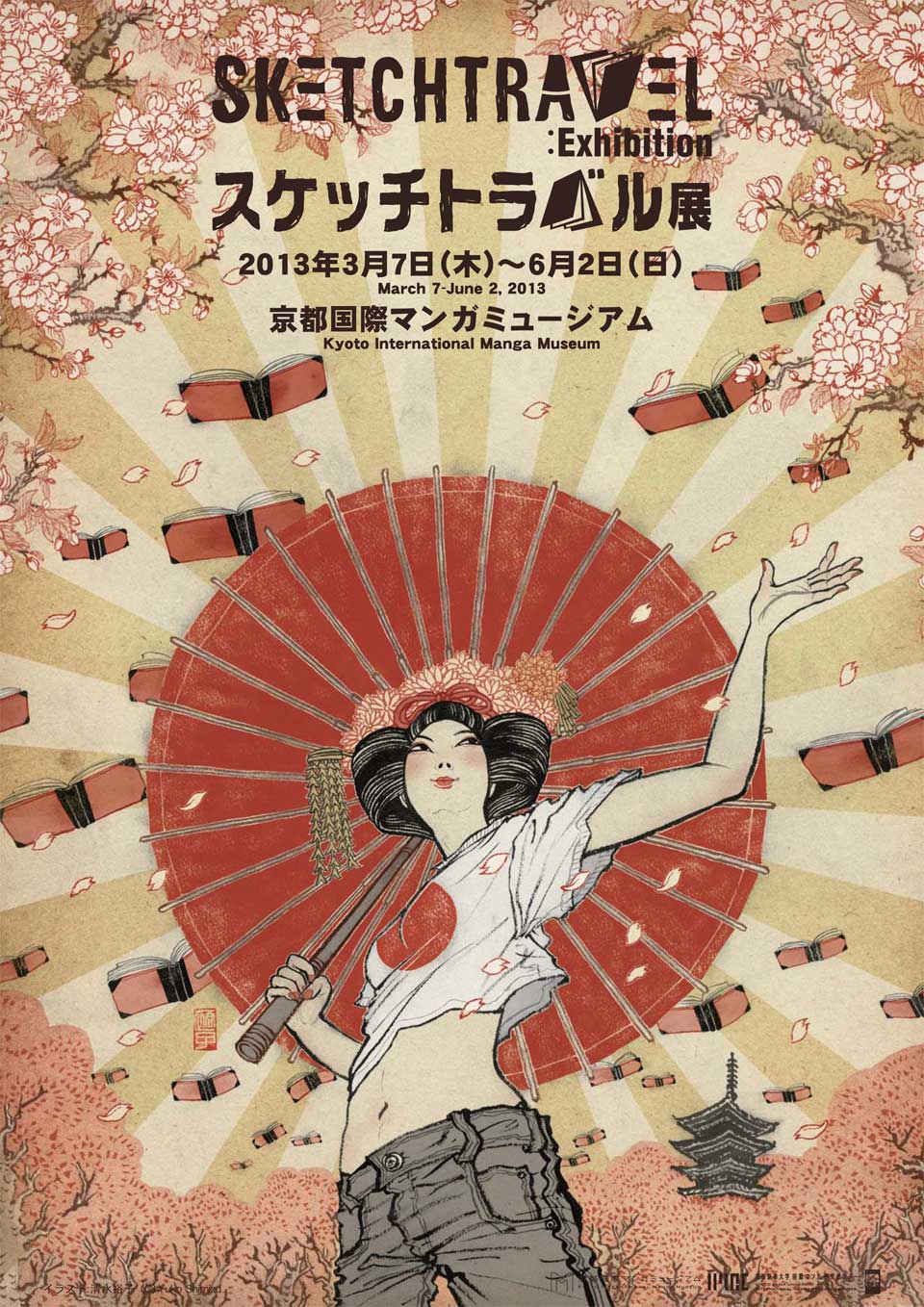 this is the finished poster. Let’s look at the creative process from the beginning….
this is the finished poster. Let’s look at the creative process from the beginning….
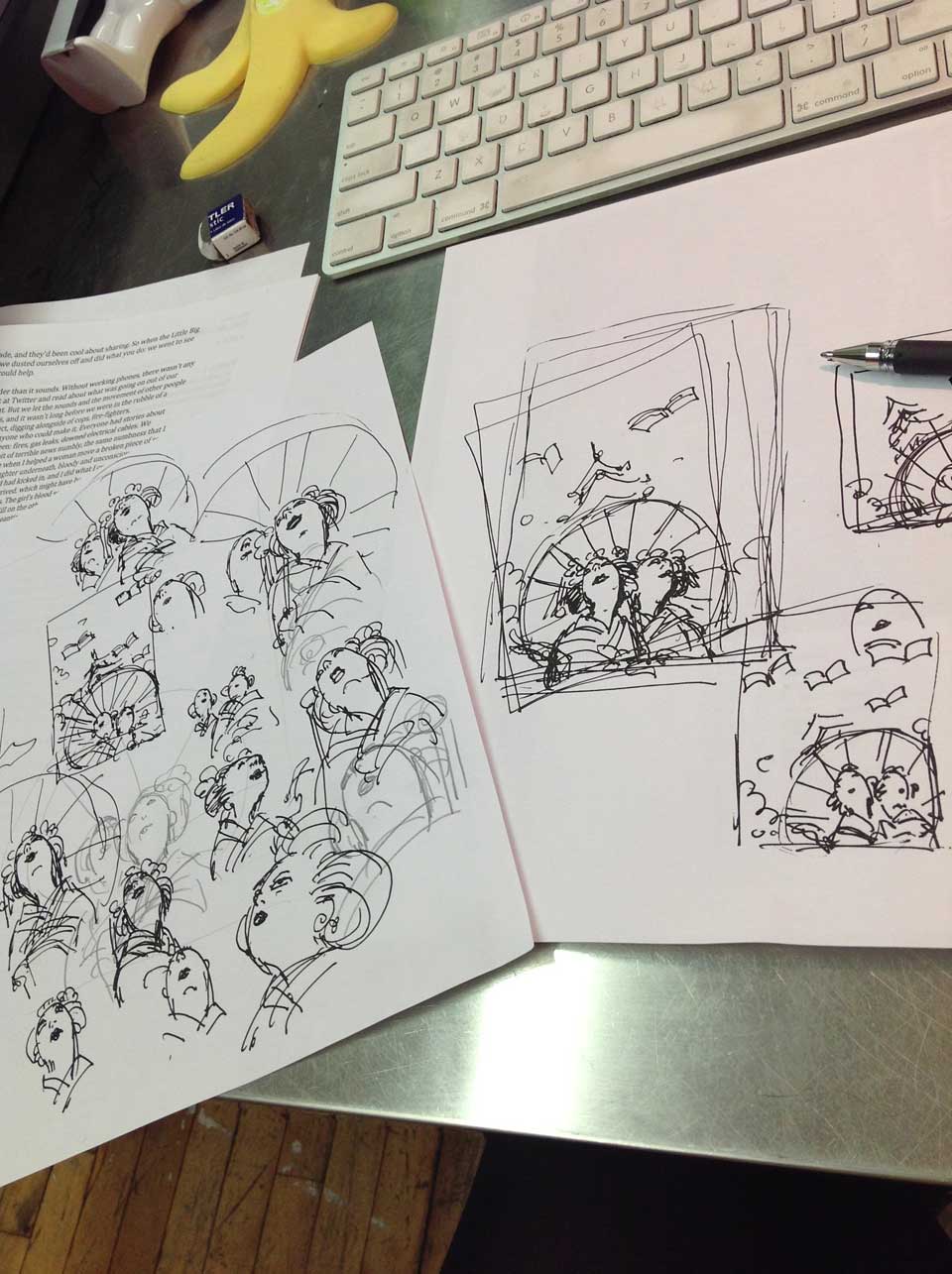
everything starts kind of like this…. lots of doodles and thumbnails.
Concept started off as drawing a “Maiko” or two. Maiko is a younger version of Geiko (what westerners know as geisha). Both Maikos and Geikos are close to extinct in this 21st century Japan, but in old capital of Kyoto, the culture still exist.

So, this was my initial idea. Dice and I discussed and decided to go with a more contemporary take on Maiko culture. He said he wanted to see more of my “edge”. I was a bit weary at first… but said OK, I will do it.

Second idea. More with edge and tradition mixed with contemporary. Japanese umbrella she is holding makes the shape of Japanese flag: red dot. Cherry flowers, of course, are the symbol of spring. Luckily, the show starts in spring, right around the famous Japanese Cherry Flower season.
 This is a typical preparatin stage before moving onto actual inking stage. Add gutter space (in grey) and blow up the sketch to the size I am drawing. For a poster use, I usually go 22″ x 30″. Obviously, it takes multiple print outs from my Epson printer and lots of cutting and taping…
This is a typical preparatin stage before moving onto actual inking stage. Add gutter space (in grey) and blow up the sketch to the size I am drawing. For a poster use, I usually go 22″ x 30″. Obviously, it takes multiple print outs from my Epson printer and lots of cutting and taping…
 Lightbox saves your time (therefore your life). You can see the traced pencil linse on watercolor paper. this is about the tightest I normally trace. No tracing takes longer than a few minutes. It is more about transferring the sketch composition onto the paper. No more no less. It is my trick to ink fresh lines and not making it look like traced.
Lightbox saves your time (therefore your life). You can see the traced pencil linse on watercolor paper. this is about the tightest I normally trace. No tracing takes longer than a few minutes. It is more about transferring the sketch composition onto the paper. No more no less. It is my trick to ink fresh lines and not making it look like traced.
Some things cannot use shortcuts. So, I take good old compass to draw out the perfect circle for the umbrella.
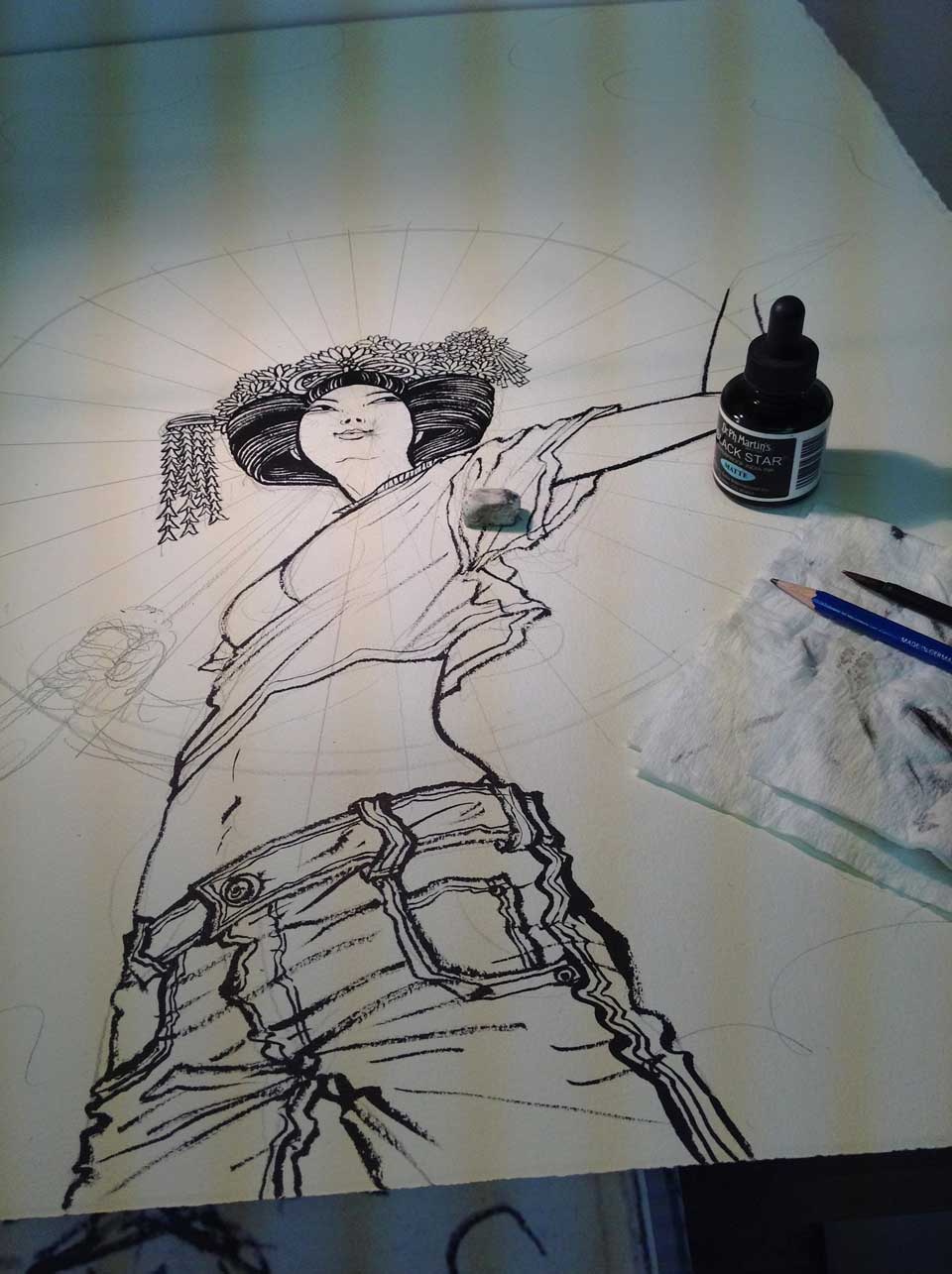 Finish figure first, then the rest follows. Face ended up changing a lot from the sketch, but that’s part of the process. Only time I do tight face sketch is when I am doing a portrait.
Finish figure first, then the rest follows. Face ended up changing a lot from the sketch, but that’s part of the process. Only time I do tight face sketch is when I am doing a portrait.

I initially thought I would finish the drawing much faster, then ended up taking longer, because of large scale, and because of detailed cherry flower drawings.

Yaaay, getting very close to finishing up the drawing. The book on the side was the book I referred to to draw various different types of cherries. Top was very close up, bottom was far away, and petals were drawn on separate paper.
Also, bunch of photos of real Maikos from kyoto, their hair style and accessories were downloaded from the web, as well as the famous five story pagoda, a symbol of Kyoto.
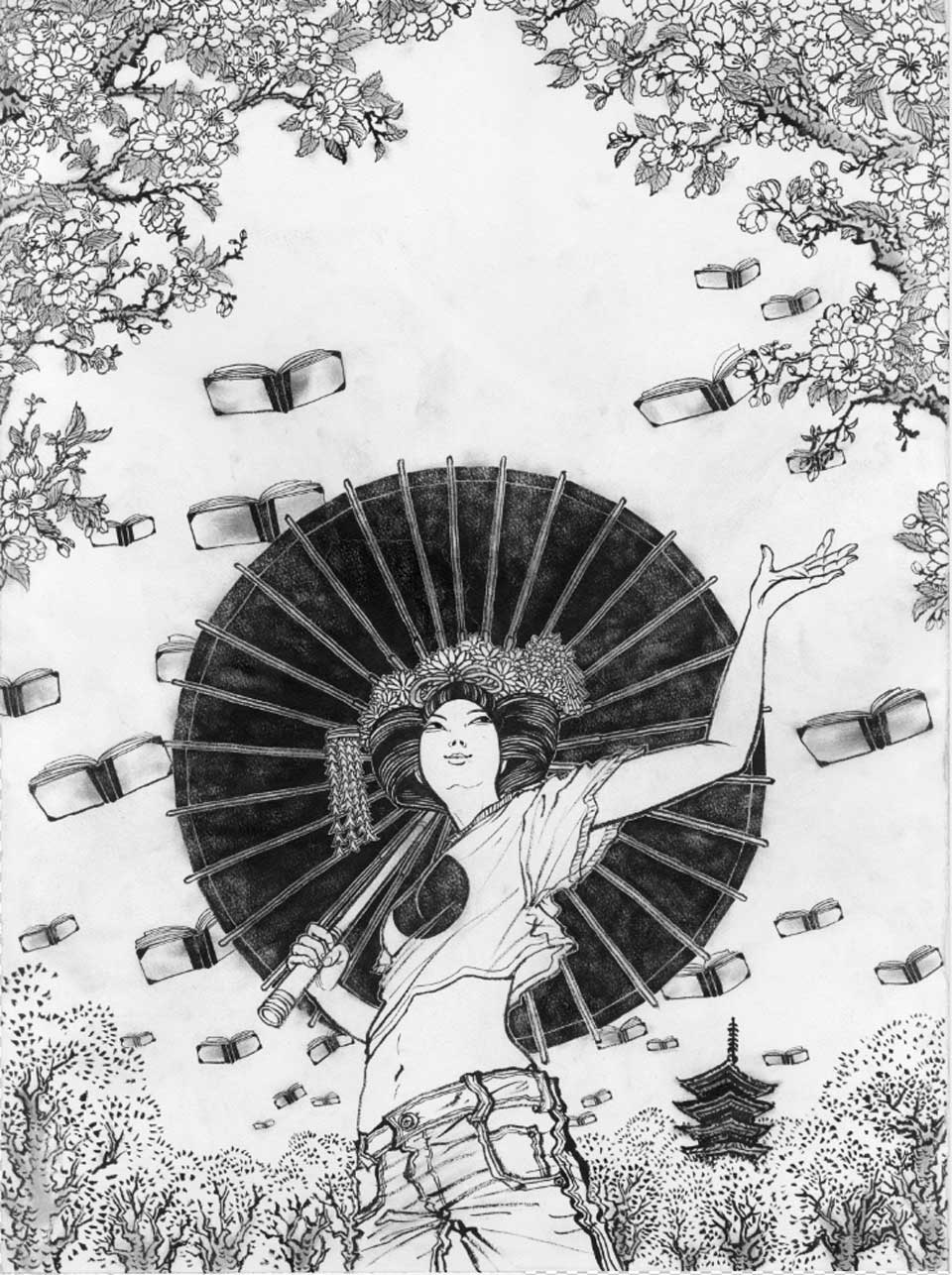
FINITO! (there is a bit of time-consuming process of getting the texture and tone on the finished drawing, which I ask to keep it as ‘secret ingredient’) This gets scanned in tediously in parts. Yes, I do have a large format scanner (Epson Expression 10000XL), but it still takes at least four scans to get everything onto the computer. At least, Photoshop Auto-merge feature works like a dream and saves a lot of time.

Adobe Photoshop CS5.5. I should switch to Ps6…. Wacom Intuos 3 tablet (which died since, and now I am on super shiny Intuos 5). Every coloring process is different, and this is one of the reasons why it is very hard for me to hire a coloring assistant. But most of the coloring starts something like this…
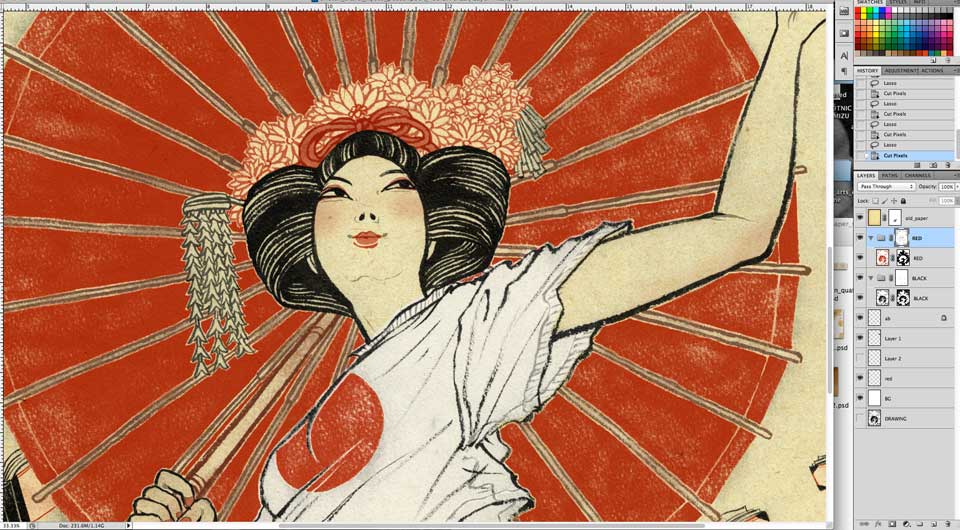
Getting there, but still not many layers. I know, I am a huge fan of masks. It is all about masking and masking and masking stuff….
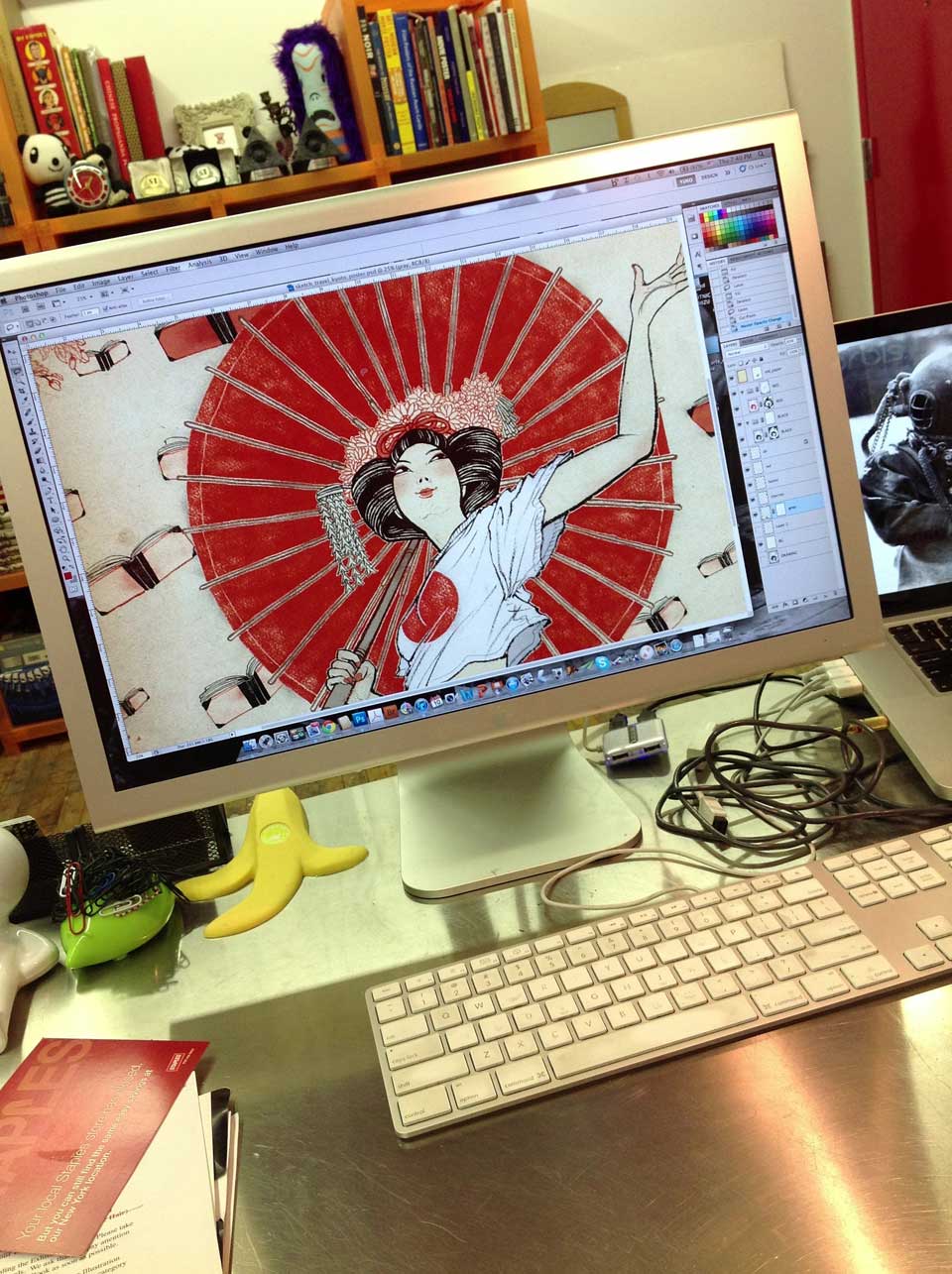
This is my workspace… I have a large Apple Cinema Display (old one, died once and paid a lot of money to fix) next to the laptop. I don’t own a desktop computer and I never will. (and that keyboard died since then. Now I have a cute code-less.)
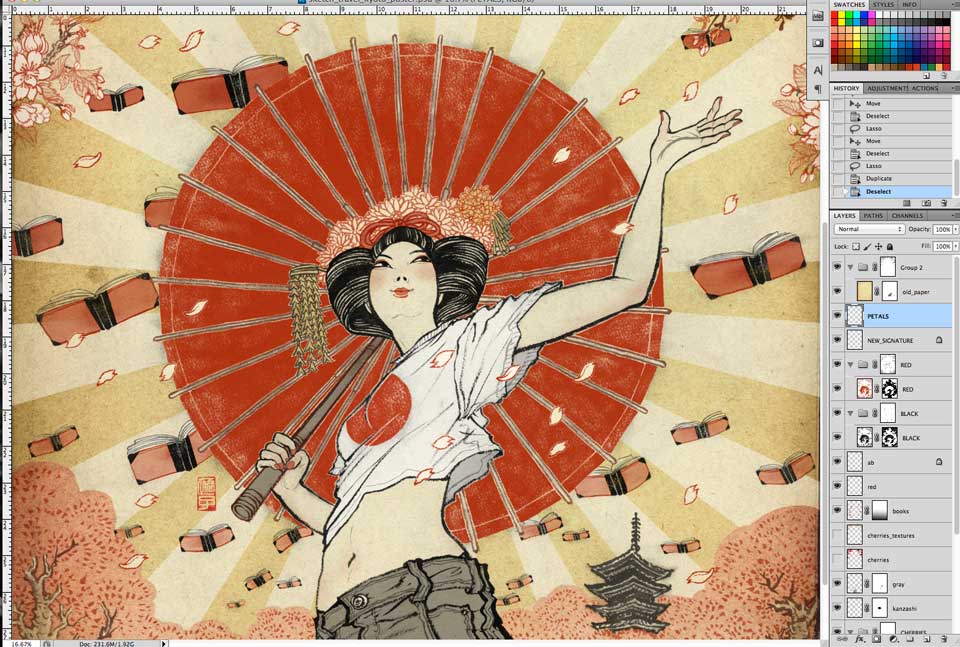
Cherry petals are inserted, and the number of layers are doubled. I think I call it done!
Once again, below is the final result, and there is a copy of the backside of the flyer on the bottom, for those of you who are in Japan who are interested in going to the exhibition.
I won’t be able to make it to the show, but I am sure it will be super, so enjoy!

